|
|
Post by dbutler69 on Oct 21, 2020 9:26:47 GMT -5
Odd color scheme aside, I think Baron Blitzkrieg has a fantastic costume. I also like him as an All-Star Squadron foe, but I agree that he hasn't had a spectacular group of baddies to back him up. Decent, but nothing special. I actually liked Axis Amerika from the Young All-Stars. I wish they could've faced the All-Star Squadron. The basic design is fine; it's just that color scheme. Zyklon just looks kind of generic. I wish Ordway was still around, at this point, as he had good design sense when it came to this sort of thing. For Baron Blitzkrieg, I would think using the colors of the party flag would make more sense: red, white and black. Agreed on BB! |
|
|
|
Post by codystarbuck on Oct 21, 2020 16:29:59 GMT -5
All-Star Squadron #47 Cover by some rookie named Todd McFarlane, with inks by veteran Tony DeZuniga. I don't know if this kid is going to make a dime in comics. Is Nabu doing rhythmic gymnastics or something? You know, with that silly-looking ribbon swirling..... Creative Team: Roy Thomas-writer/editor, Tod McFarlane-pencils (pg 2-23), Mike Clark-pencils (pg 1 & 24), Vince Coletta-inks, Cody Weiss-letters, Gene D'Angelo-colors Interior cover has a crowing fest about Swamp Thing being rated #1 of the Best Ten Books of 1984, by Amazing Heroes. The list is split evenly, with Dc with 4 titles, Marvel with 4 titles and 2 independents (all from First Comics). 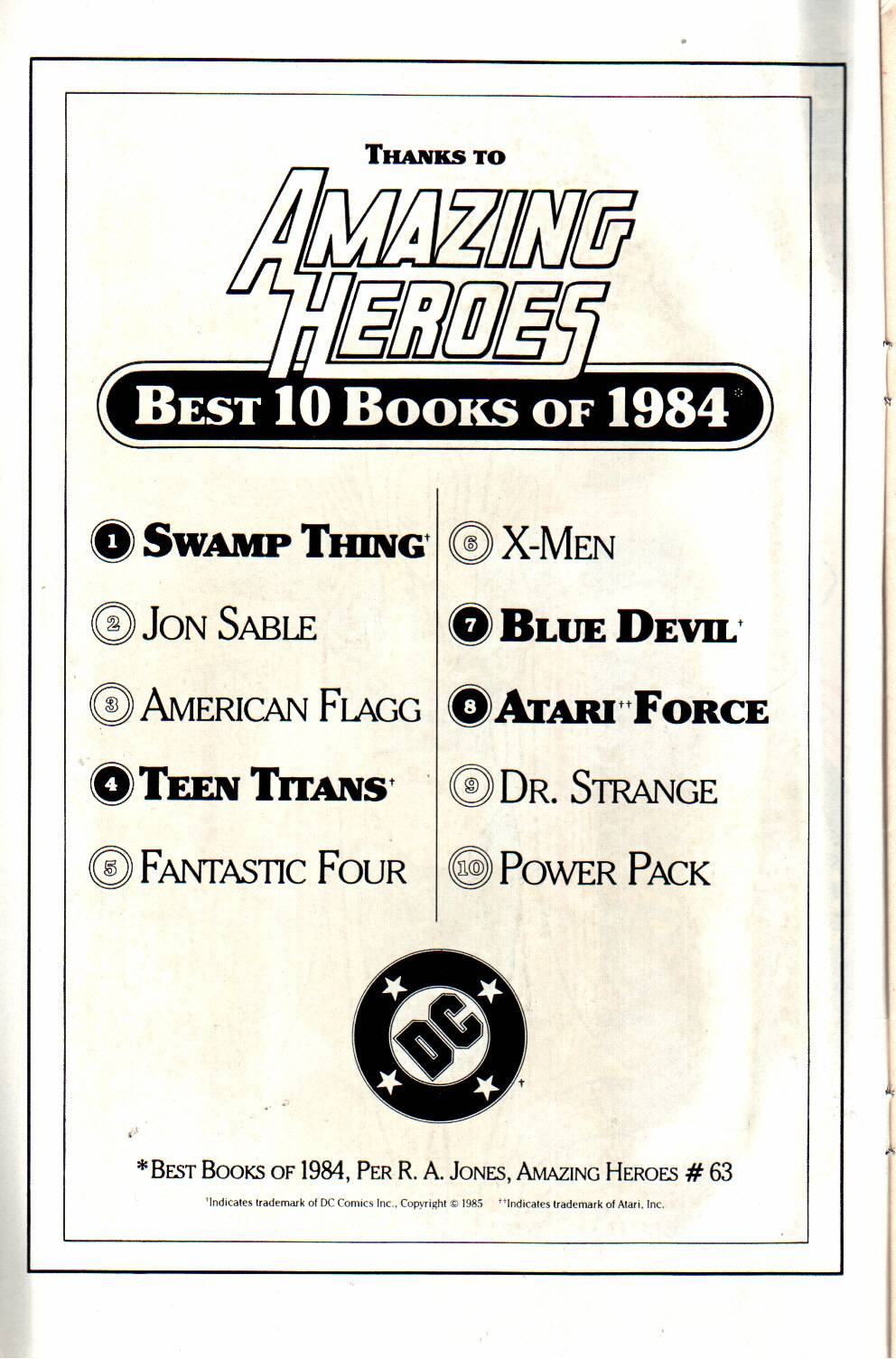 The list is chosen by RA Jones, so it isn't sales based, which is probably evident by Blue Devil and Atari Force. Both are great books; but, I don't think they were lighting up the sales charts, compared to other books. It does illustrate how far DC had come in just a few years, post-Implosion, under the leadership of Jenette Kahn, Dick Giordano and Paul Levitz. Synopsis: Starman got the origin last time (before the Liberty Bell stuff); so, why not Dr Fate? I guess that means he will suffer a crisis of confidence over the next few issues, too. He and Starman enter the meeting chamber, at the Perisphere and offer to tell Tarantula his life story, for his book. Dr Fate looks like his helmet has been tagged by Tarantula, while he was sleeping or something... 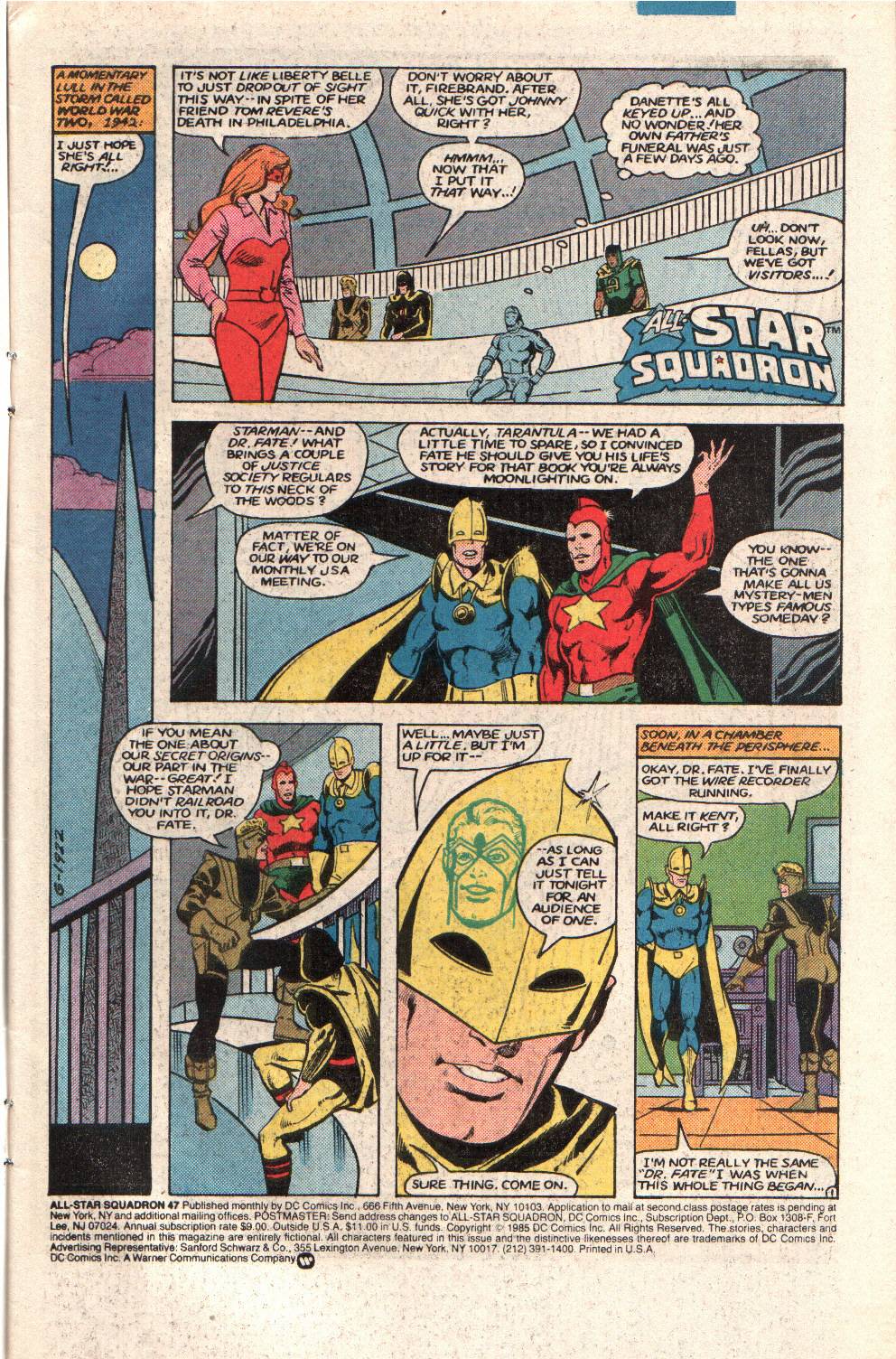 It's supposed to be a reflection; but it looks more like graffiti. They fire up a wire recorder...  and then everything goes all McFarlane. 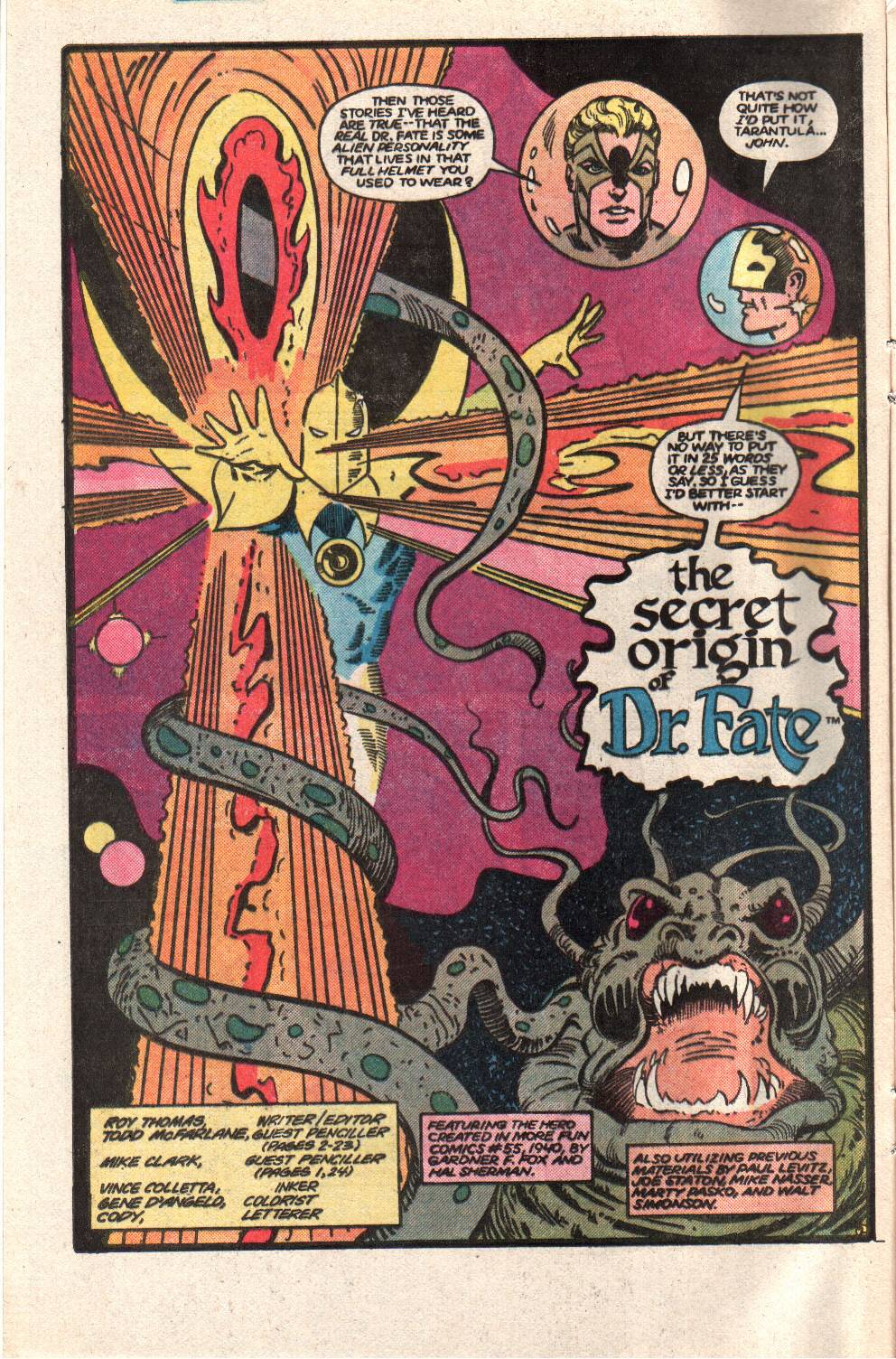 The year is 1920 and archeologist Sven Nelson has-a been a-tapped to head a dig of Ur, in der Mesopotamian Valley, by ymininy! He brought his-a derboy, Kent, instead-a Mrs-a Whiggins, ta-hee-dee-hee! They are excavating an Egyptian pyramid, which is located among the Sumerian ziggurats. The locals want nothing do do with going inside. Dr Nelson consults with Dr Jones, who is busy playing with his whip, so he moves on. He takes little Kent inside, because there is no Health & Safety officer there and archeologists are an irresponsible bunch, blundering through ancient sights, setting off booby traps, knocking over statues and stealing Arks. Kent spots some treasure, while Sven notices weird writing that is neither Egyptian or Sumerian and makes the big leap in logic that it confirms his theory that the pyramids and ziggaruts were built by aliens. Kent von Daniken watches his father, lost in delusion. He goes off to amuse himself, oblivious to any snakes or other dangers that might be inside a cool, rak place in the Middle East. He comes across a big, bearded, half naked man, who somehow compells him to move a lever and bring him to life, where he reaches for Kent. 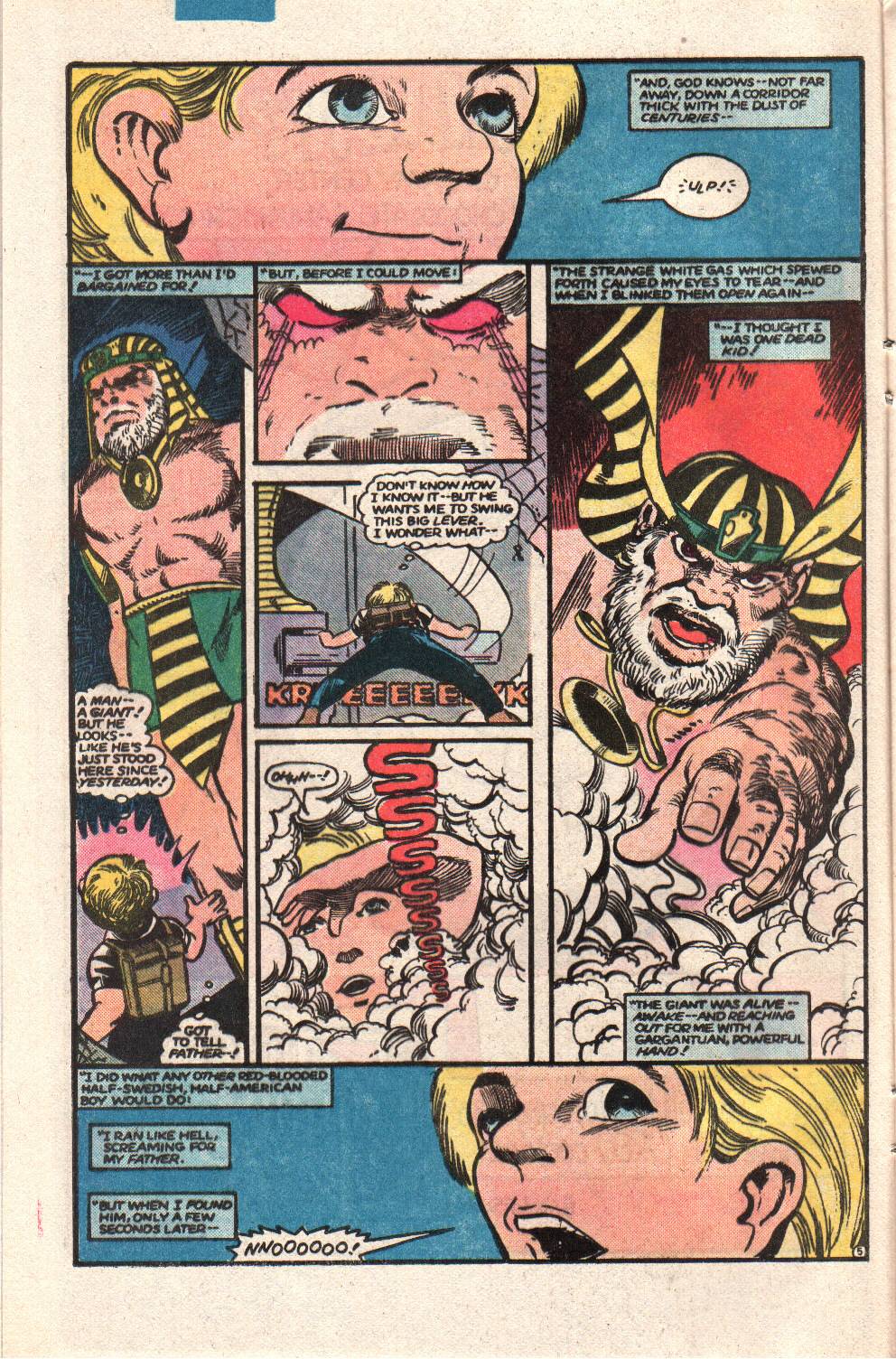 This is all rather creepy, in an unintended way, if you ask me. Kent goes screaming for dad and finds him dead. Nabu says he can't help him, but he can teach Kent the secrets of the universe, whether he wants to or not. He then shuts off the entrance to the pyramid. Kent is mind-whammied and then trained, after Nabu buries Sven and makes the pyramid disappear. Kent learns the secrets of ancient magic and grows older, then is released by Nabu, so he can blast him and reveal a glowing orb inside. He learns that Nabu came from the planet Cilia, which orbited near Earth, and was sent down by the Lords of Order. Ancients worshipped him as a god. 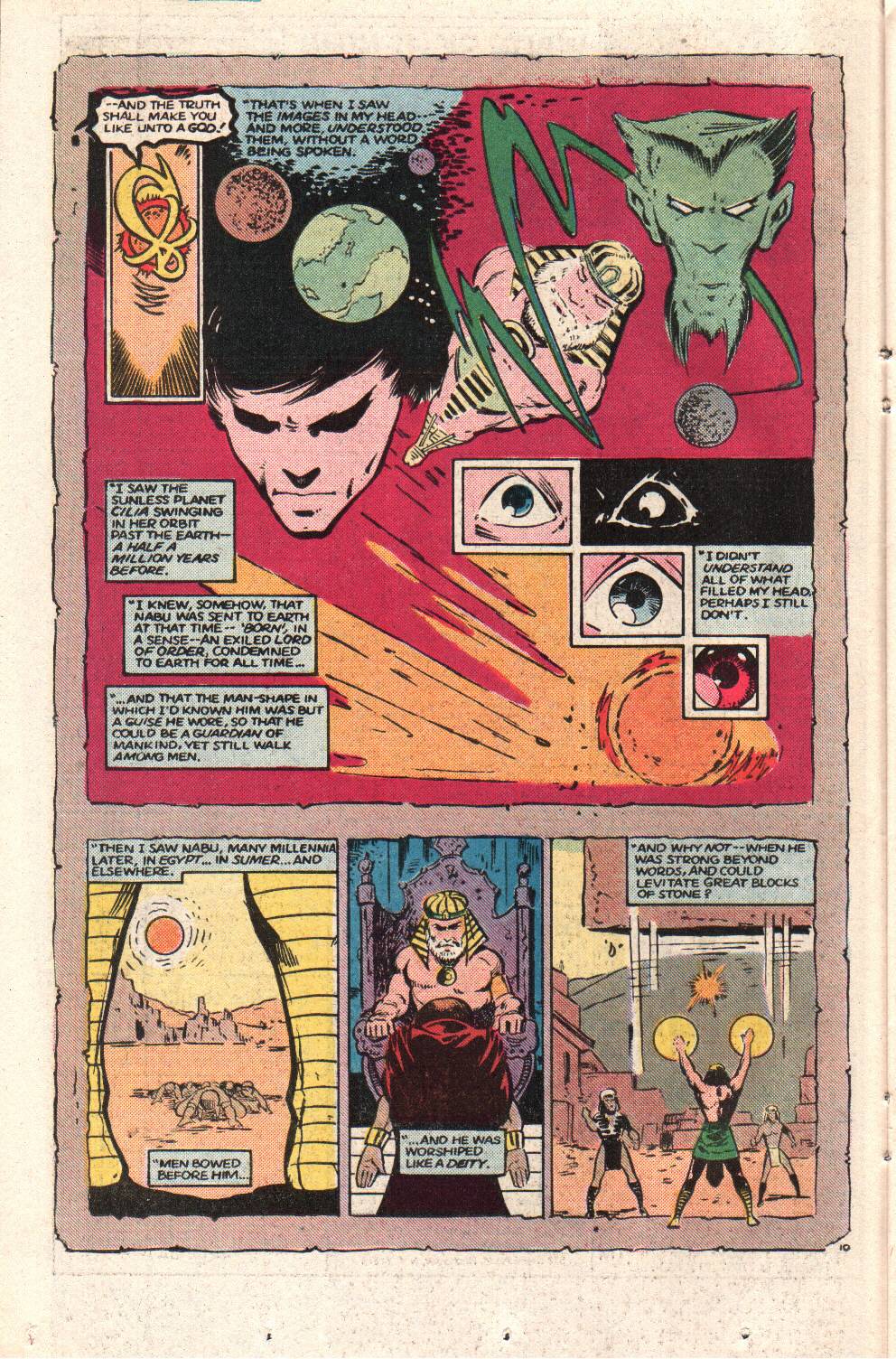 He says he needs a new host and that is Kent and he then gets a snazzy cape, amulet and a swell helmet and becomes Dr Fate. He goes off to the hidden Library of Alexandria, to borrow some books and runs across a dead guy in an over-turned auto, in the desert. He fashions a crystal ball and sees Inza being held prisoner by Wotan and goes off to free her. He finds a windowless tower in the desert, flies through its wall and finds Wotan and Inza engaging in mystical BDSM. Wotan challenges him, but Fate has no idea who Inza is, so Wotan tries to tempt Fate to his side. He rejects him and they magic fight... 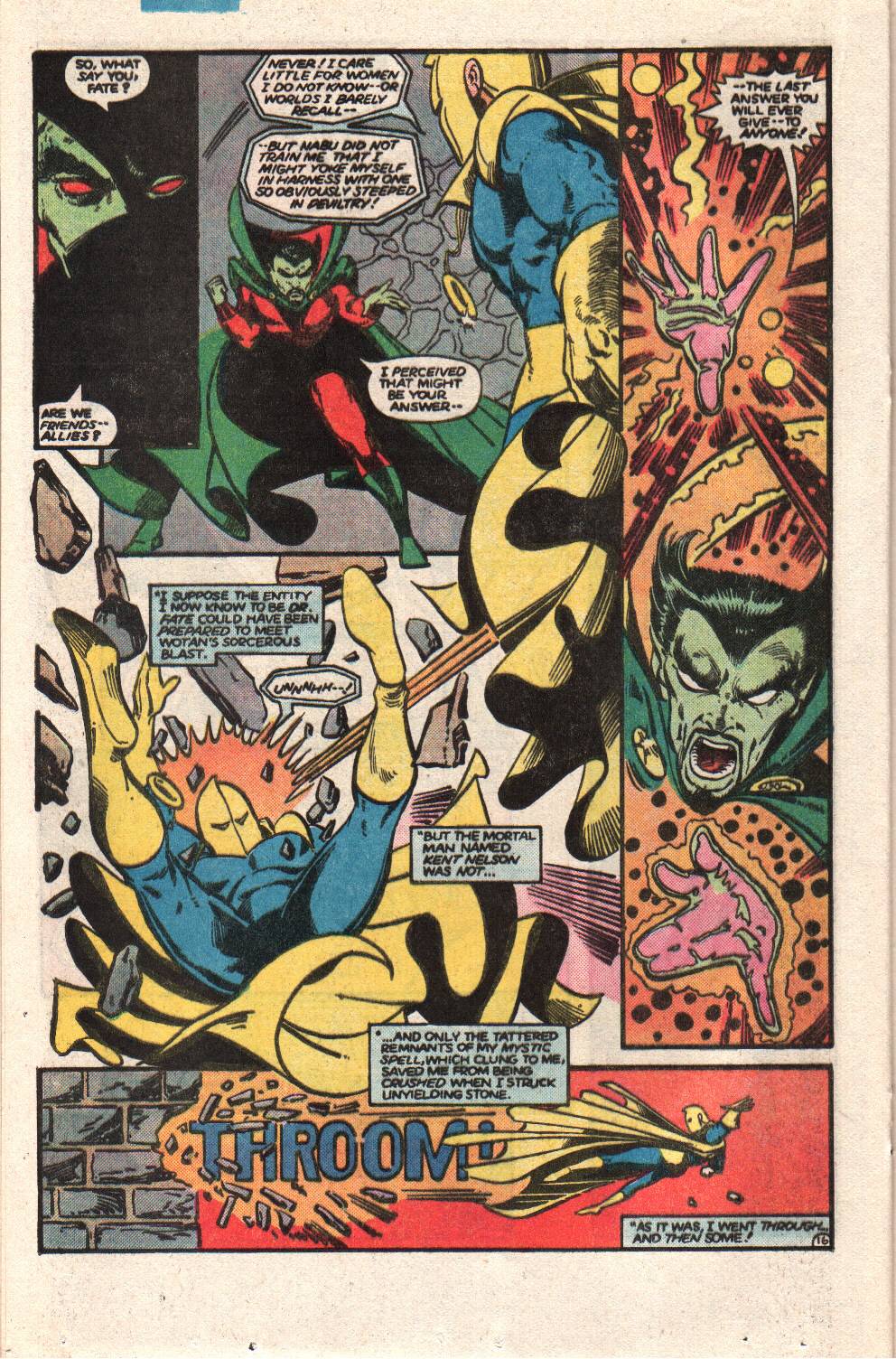 Wotan blasts Fate out of the building, then interrogates Inza, who says she is Inza Cramer, a tourist doing some sight-seeing, before school starts back up and to go pound some sand. Wotan takes her with him, even though she mocks his skin color with racist taunts. Fate turns up again and gets swatted. He tries again and goes down. Inza makes goo-goo eyes and pleads for Wotan to stop, which just encourages the bully. Inza goes over to Fate and removes his helmet, revealing the manchild inside. Wotan laughs and she blubbers and her tears fall on Kent. He is energized, puts the helmet back on, pops the strap and starts whoopin' Wotan, because it is "time to go home." Wotan "does the job" and gets pinned and then Fate stomps out his tower. He then picks up Inza, whose breasts are about to fall out of her torn shirt and they fly off together. Fate finishes his story when Hourman interrupts, saying that FDR sent a message that Churchill needs Dr Fate or the Spectre in England. The end blurb says something about Camelot 1942; but, Lerner and Lowe haven't created that, yet. (Heck, TH White hadn't completed The Once and Future King, yet). Thoughts: Interesting enough tale, though it wasn't that long ago that Dr Fate appeared in First Issue Special and in the Flash, in back-up stories. The story reads rather like a child kidnapping case, if you think about it for a minute, which makes Fate's origin really messed up. They threw in the Von Daniken nonsense of alien civilzations creating Babylon and Egypt and the Incan cities, with no proof whatsoever of alien origin, other than over-active imagination. Sure, it sounds cooler than the developed faster than other societies in the area (which more than likely migrated to those areas later, rather than originated alongside the more advanced people); but, sounding cool and offering proof are two different things. McFarlane does a pretty decent job, with plenty of ankhs and such, following Walt Simonson's lead (which Keith Giffen carried forward, leading to Todd). McFarlane is more restrained at DC, as he was being tutored by Dick Giordano, polishing off his rough edges. Also, Coletta doesn't ink what he doesn't want to. Still, McFarlane was a interesting artist, in this time frame, as his page compositions livened up occasionally dull stories, from Roy, in the pages of Infinity, Inc and here. Todd would add things liek characters holding up panels, or character symbols around the borders and he understood the value of designing a page towards resale after the story was complete. His pages are mini-posters and, in that, he always had great design sense, even if his storytelling needed work. Personally, I prefer his earlier stuff to his Marvel work and any of that to Spawn, as it was so derivative of about a dozen features and spent most of its time having the character pose on rooftops, while Alien-wannabes cackled. Next issue will see the return of the Shining Knight and also Blackhawk! And, we will learn why Roy felt the need to do Dr Fate's origin as a prologue. Sadly, that will be followed by Crisis interrupting things and then we start our slide to the end of the series. Historical Notes: Nothing of real note, other than the period of Kent's childhood reflects the discovery of King Tut's tomb. Steve Martin was pleased, but didn't do a song about Nabu or young Kent Nelson. August 1943 Germany ends the governing of Denmark, which had been neutral, but had been occupied by Germany, starting in 1940; and, replaces the civilian administration with military. Denmark would remain under German military authority until the surrender, in 1945. Lord Louis Mountbatten, uncle to Prince Phillip, was made Supreme Commander of the Allied forces in Southeast Asia (aka China-Burma-India Theater of Operations). He had been head of Combined Operations, since 1941 and was one of the chief architects of the failed Dieppe Raid. He had an experienced command staff who kept in check some of his wilder ideas. In 1947, he was appointed the last Viceroy of India, before the country gained independence. He was assassinated by the IRA, in 1979, when they placed a bomb aboard his unguarded boat and detonated it remotely, while he was offshore. He was recovered, alive, with his legs blown off, but died soon after from his injuries. Patton and Montgomery linked up in Messina, ending the invasion of Sicily, though not before the evacuation of large contingents of both the German and Italian forces. After the bombing of Rome, The Italian government attempted to declare Rome a free city, to prevent future bombings, based on the ancient sites there. The Women's Army Service Pilots are formally organized, consolidating the previous Women's Auxiliary Ferrying Service and Women's Flying Training Detachment. The WASPs were female pilots who carried out the duties of ferrying aircraft to military bases in the US and elsewhere, conducting flight training, and towing air targets for exercises, freeing up male pilots and instructors for combat duty. The WASPs were highly skilled and experienced pilots and 38 lost their lives in service to this country, while another disappeared, while ferrying a plane, with her fate unknown. Despite their service, they were not granted veteran status until 1977 and were not publicly recognized for their contributions until 2009, when they were awarded the Congressional Gold Medal. Their leader, Jacqueline "Jackie" Cochran, was awarded the Distinguished Service Medal (the first woman awarded the medal) and later flew jets, after the war. In 1953, using the sole F-86 Sabre in the Canadian Air Force (after being turned down by the USAF), she set a world speed record and became the first woman to fly supersonic. The Allies carried out Operation Tidal Wave, a B-24 airstrike on the Ploesti Oil Fields, in Romania. The planes launched from airfields in Benghazi and flew across the Mediterranean, to Romania and attacked their targets. However, the oil fields had one of the densest anti-aircraft defenses in Europe, particularly after a strike in 1942, also by B-24, which created minimal damage, but spurred the Germans to beef up defenses. The attack was carried out in daylight. Confusion caused by radio silence and a near collision, after an aircraft began to fly erratically and plunged into the ocean caused the flights to be spread out and out of sync when they commenced attack runs. of the 177 planes that launched on the mission (one additional was unable to take off), only 88 returned and over half of those were battle damaged. 310 air crew were killed and 108 captured, 78 were interned in neutral Turkey and 4 were found by partisans, in Yugoslavia. Five Medals of Honor were awarded for the raid, 3 of them posthumously. The raids had little effect on oil production at the targets. Additional raids were carried out through 1945, as part of the Allies overall bombing campaigns, targing fuel production and storage, industrial targets and other strategic sites. The RAF carried out Operation Hydra, a bombing mission, targeting the Peenemunde rocket facility, where the V-2 was undergoing development and testing. This was the start of the larger Operation Crossbow, which targeted German rocket sites and facilities. During the mission, a master bomber designated the targets, for other bombers to attack, for greater accuracy. The raid succeeded in disrupting testing, forcing a dispersal of test subjects and seriously affecting the morale of operational staff. The plan called for bombing at 8,000 feet, instead of the normal 19,000 ft, targeting workers quarters and research facilities (in that order). The goal was to kill or maim as many of the workforce as possible, then destroy as much of the research material. Diversionary attacks were launched to draw away fighter protection, with a Mosquito raid on Whitebait (Berlin), which simulated pathfinder strikes for a larger bombing attack. This was followed by Mosquito and Beaufighter attacks on German airfields. The main force attacked in 3 waves, with the first wave targeting the quarters for research scientists. however, errant markers led to slave labor huts being bombed and some 5-600 were killed in the raids. Soft grounds muffled some of the bombs, though time delayed fuses, some up to 3 days, created additional casualties and hampered salvage efforts after the raid. Th strategic value was minimal, as the end result delay in testing and production was only about 6-8 weeks. At the Battle of Vella Gulf, the US Navy destroyed a group of four Japanese destroyers, when 6 US destroyers were allowed to operate independently of cruiser forces. they approached the Japanese without detection and launched torpedo attacks, sinking 3 of the 4 ships, preventing them from landing troops, with no loss of American ships. The Navy had been alerted to Japanese intentions to land reinforcements and dispatched the destroyers independently to stop the Japanese destroyers. the flotilla was under the command of Cdr Frederick Moosebrugger, who split his group into two divisions, using three that were still armed completely with pre-war torpedo tubes and the others, which had additional 40 mm guns replacing some tubes, to act as cover and available to launch a second strike, if necessary. The destroyers lay in the shadows of Kolombangara, using the islands mountainous terrain to mask their silhouette, while also figuring it would mask any radar signature, as the earlier US models couldn't differentiate between terrain and a vessel, at that range. As it was, none of the Japanese ships had radar and could not differentiate the destroyer silhouettes from the mountains of the island. The strike division fired 24 torpedoes, in a span of 63 seconds and turned to starboard. They withheld gunfire until the saw torpedo hits, after the lessons of previous torpedo attacks, including those by PT boats (more in a moment). As soon as the torpedoes hit, the covering force crossed the T (moved in line, perpendicular to the Japanese ships) and fired their guns. 3 of the 3 Japanese destroyers burst into flames and were sunk nearly immediately from the torpedo hits or gunfire. the fourth, the Shigure, was hit by a torpedo; but it was a dud and passed through their rudder, allowing them to escape. They launched 8 torpedoes as they fled, but none hit their targets. The Japanese abandoned attempts to resupply Kolombangara and it was bypassed and cut off by the Navy, with landings at Vella Lavella. The Navy attempted to rescue the Japanese sailors and soldiers, but they refused rescue and 1200+ were lost in drowning or injury. CDR Moosebrugger was later promoted to vice admiral and the Spruance class destroyer, USS Moosebrugger ("The Mighty Moose') was named in his honor. It was homeported in Charleston, SC, where I was stationed, as part of Destroyer Squadron 6 (I was attached to Destroyer Squadron 4). The two command staffs shared a building (we had the top floor, while DESRON 6 had the ground floor) and we assumed command of the squadron, when the command staff deployed to Bahrain, during Operation Desert Storm. The Moosebrugger was part of the Kennedy's battlegroup, during the operation. Part of my duties included compiling reports about vital repair work on our ships and tracking down repair parts and expediting delivery for those repair jobs, including those deployed during Desert Storm. It was amazing how quickly manufacturers could get us a part, with the fighting going on, compared to the previous few months, when the standard answer was "6 months," for the same parts. A fellow lieutenant and I used to grouse about how the USS Yorktown went from the Battle of Coral Sea to the Battle of Midway, in 72 hours, with round the clock repairs, and we struggled to get civilian repairs on a steam pipe. Now, all we had to do was ask them if they were aware of events on the other side of the world and the fumbled over themselves to assist. One of the preludes to the Battle of Vella Lavella was a combined PT boat strike on Japanese destroyers of the Tokyo Express. PT Boats were built in the hundreds, between 1942 and 1945. Their hulls were made of of two layers of mahogany planking, which gave them excellent speed, but little protection. They were crewed by 3 officers and 14 men, displacing about 56 tons, fully loaded. They were equipped with powerful engines, capable of reaching 41 knots, though such speeds were pretty rare, due to the waters and reefs in the Solomons and the lack of sufficient repair parts to maintain the engines properly. crews often modified the boats, adding additional armament to give them a better punch. The Mark torpedoes proved troublesome, as they were inaccurate at greater distances and often didn't arm properly. One of the Pt-boats in the strike was captained by Lt(JG) John Fitzgerald Kennedy, son of former US Abassador to England, Joseph P Kennedy. The younger Kennedy had graduated from Harvard, where he had been a top swimmer and involved in sailing. Despite a chronic bad back and asthma, Joseph Kennedy was able to use his influence to get John accepted into the US Navy, at the Office of Naval Intelligence. However, an affair with Danish journalist Inga Arvad created a bit of trouble. Arvad had been a guest of Adolf Hitler, at the 1936 Berlin Olympics, and she was suspected of being a spy by the FBI. Investigation found no proof to back up those fears, yet the FBI continued wiretapping Arvad and Kennedy. The Assistant Director of the ONI, Captain Howard Klingman, wanted kennedy out, though his superior, Capt Seymour Hunter didn't believe he had access to anything sensitive; and, at worst, it was just a mild embarrassment. Kennedy was reassigned to Reserve Officer Training School, in Chicago. His father's influence again interceded and LCDR John Bulkey approached Kennedy about joining the PT-Boat service and he was transferred and sent to school. Bulkey was impressed with Kennedy's grades at Harvard and his experience in sailing, as part of the Harvard sailing team, as well as his communication skills and confidence. Kenendy graduated from his training course with high marks and was asked to stay, for a brief period, as an instructor. He then transferred to Motor Torpedo Squadron 14, in the Panama, patrolling the Canal. He again used family influence to get himself reassigned to the Solomons, where he took command of PT-109. On August 1, 1943, 15 PT boats sailed to a position near Kolombangara, to intercept 5 Japanese destroyers, scheduled to move through the Slot and land troops and supplies. The group was split into 4 sections, to fire torpedoes at the destroyers. Some 30 torpedoes were launched, without a single hit. Kennedy's section was led by PT-Boat 159 and the boat received radar blips of a destroyer approaching their sector. Three of the boats moved off to attack; but, PT-109 was not radioed and alerted and left in fog and darkness. The PT-Boat radars were weak and often failed to operate. Around 2 am, the destroyer Amagiri was bearing down on the boat, which was idling, to reduce it's wake. Kennedy attempted to turn and fire a torpedo, but, had less than 10 seconds to try to get the engines up to speed. Ens "Barney" Ross tried to fire a newly installed 37 mm anti-tank gun, which was lashed to timbers on the boat, but was unable to get a shell into the closed chamber before the destroyer collided with PT-109, severing it. The collision ignited the boat's aviation fuel and the explosion immediately killed two men and badly burned 2 more. Kennedy rescued MM1 Patrick McMahon, who had 3rd degree burns over 70% of his body, and got him to the floating bow section. He then rescued two more from the burning water (burning fuel floating on the surface. The bow section drifted and eventually had to be abandoned. The planking that had held the anti-tank gun was used to swim to Plum Pudding Island, which was one of the few nearby without a Japanese presence. Shoes, lanterns and non-swimmers were put on the planking, where thet propelled it by kicking their feet. Kennedy swam for shore, while towing McMahon, by grasping a chord from his lifejacket between his teeth. The survivors made it to shore, without encountering sharks or crocodiles, which were threats in the waters of the Solomons. Plum Pudding had no food or water, which is why the Japanese hadn't occupied it. The men hid inside the treeline, to avoid detection from air or landing barges supplying the Japanese. On Aug 2, Kennedy swam 2 milesto Ferguson Passage (a gap in a coral reef) to try to signal passing PT-Boats, without success. On Aug 4, he and Lenny Thom led the men on a tough 3.75 mile swim to Olasana Island, which had coconuts. Kenendy and Ross them swam again to Naru Island, looking for food and water and in an attempt to spot any PT-boats. they found a canoe, left by the Japanese and used it to return to the men. They then encountered two Melanesian coast watchers and Kennedy was able to communicate in pidgin english, learned from a native bow a few months earlier. The men gave them some yams and other provisions and vowed to get help, taking a coconut, carved with a message (the idea of one of the coastwatchers, not Kennedy, as seen in the movie). The caostwatchers were under the guidance of Sub-lieutenant Arthur Evasn, of the Australian coastwatching service. he spotted the explosion of the aviation fuel, from his position on Kolombangara and dispatched the two natives to search. They were investigating a wreck on Naru when they spotted the men. They first thought they were Japanese, until Kennedy was able to communicated in pidgin english. The carried back the coconut and, slowly, made it to the PT base at Rendova. Evans, having been alerted, further radioed the base, which finally convinced the squadron commander that the coastwatchers were speaking the truth. PT-157 was dispatched and reached the survivors on August 8th. Regardless of political belief, propaganda or revisionist history Kennedy acted in the finest traditions of the Navy, exercising a cool head in a crisis and strong leadership, collecting his surviving crew and keeping them together, then leading them to safety. He was a "hero," not because the media said so, not because of his prominent family, not because of his uniform; he was a hero because he carried out heroic actions. He undertook great personal hardship to find food and water and alert possible patrols to their position, at the expense of an already bad back. Kennedy was reassigned to PT-59 and carried on with his duties, though his physical condition deteriorated, over time. he remained close friends with Lt Thom, one of the officers of the 109, and was a pallbearer at his funeral, after a car crash in 1946. The coconut came into the possession of Ernest W Gibson Jr, of the 43rd Infantry Division, who was serving in the Pacific. He later returned it to Kennedy and it was kept in a glass paperweight case, on his desk, in the White House. Kennedy was recommended for a Silver Star, but was awarded the Navy & Marine Corps Medal (as were the other two officers, Thom and Ross), as well as the Purple Heart, for his injuries during the explosion. Kennedy may have been the privileged son of a wealthy and influential family (though Joseph Jr was the one who was supposed to become president, but died when his bomber was shot down), Kennedy, despite health issues, joined in with the war effort, in the US Navy and was rated as a good skipper of his PT-boat. He demonstrated leadership and a calm demeanor, which are the two greatest strengths an officer has in combat. 
|
|
|
|
Post by codystarbuck on Oct 27, 2020 23:50:08 GMT -5
All-Star Squadron #48 Creative Team: Creative Team: Roy Thomas-writer/editor, Mike Harris-pencils, Vince Coletta-inks, Cody Weiss-letters, Carl Gafford-colors Synopsis: Shining Knight is out cruisn' around on Winged Victory, patrolling the skies and pooping on the countryside. He drops down and goes to check out some old ruin of a building and runs into another knight, who says none shall pass... Sure enough, the knight turns out to be Arthur Pendragon, King of the Britons (who may or may not look like Graham Chapman)... 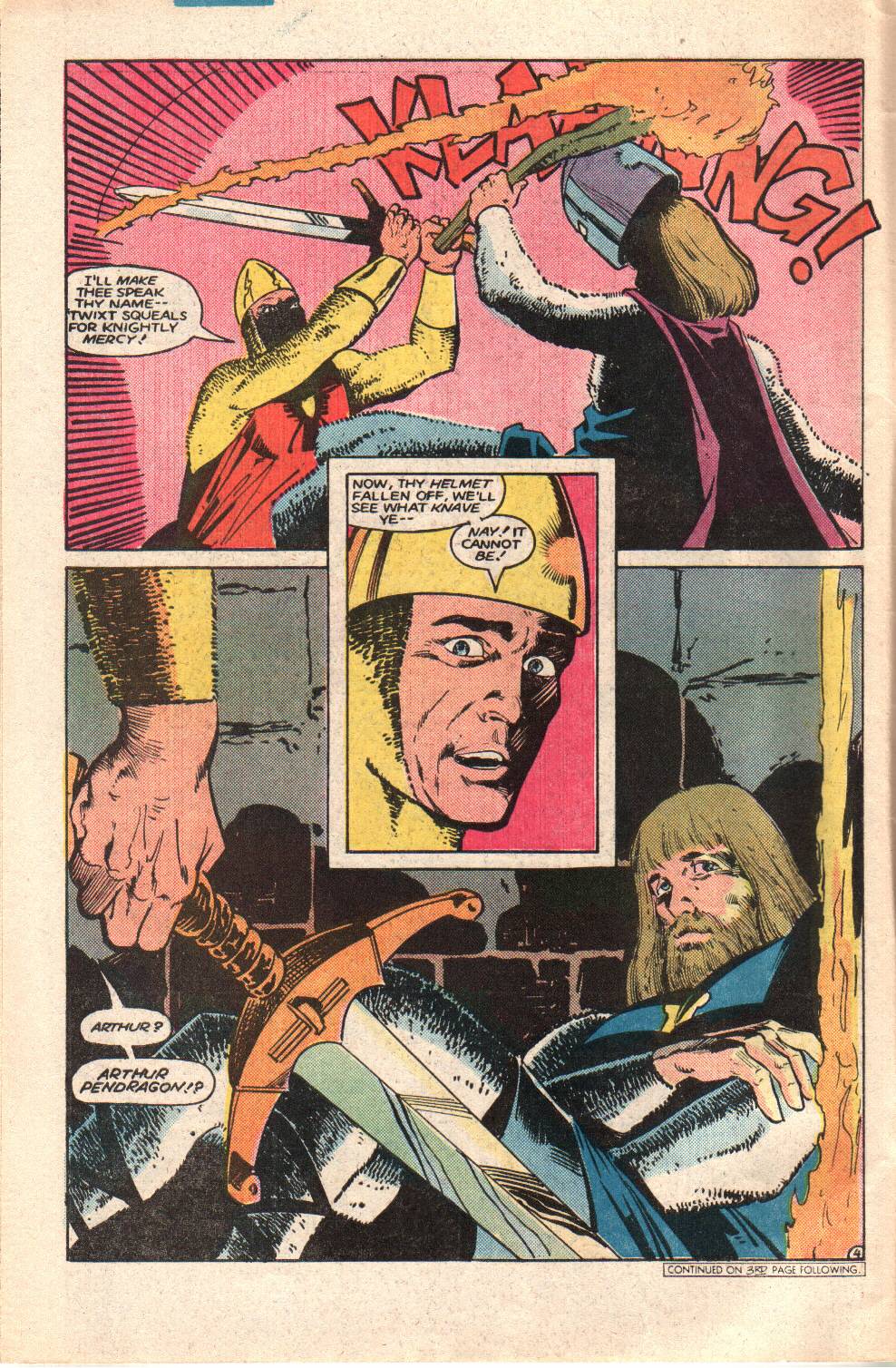 Sir Justin goes all gooey-eyed and Art has enough of it and cold cocks him. Meanwhile, a rather poorly drawn B-24 wings its way over the Atlantic, carrying Dr Fate, Hourman, Firebrand and Robotman. Firebrand is welding Robotman's new jet pack onto his body, while Hourman mopes about Dr Fate getting named for the mission and not him, while he also harbors jealousy of Danette's past with Sir Justin (they may or may not have done a bit of "jousting"). They run into some German bombers over Britain (I think they are supposed to be Dornier Do-17s; but, aircraft are not Mike Harris' strongpoint) and it's fightin' time. They All-Stars are about to bail out and attack, when some fighters dive down on the bombers.... 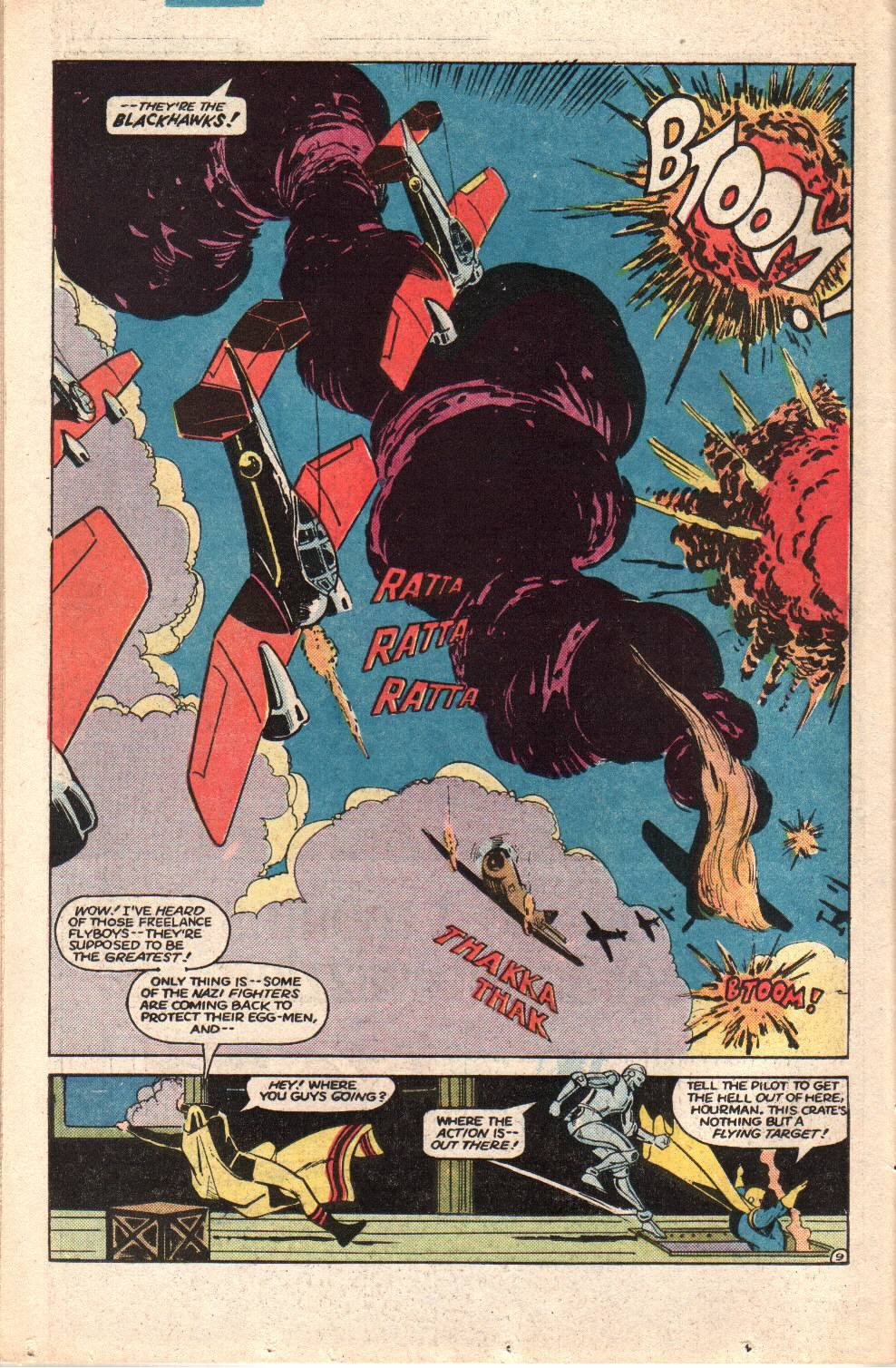 Hawkaaaaaa!!!!!!!!!! Robotman, Dr Fate and Firebrand jump out to help, while Hourman mopes some more. They slice through, slam into, and generally F-up the German planes, while their fighter escort turns up in time to get shot down. Kind of looks like this... They land and meet up with the Blackhawks, with Chop-Chop wearing his sterotyped outfit. Thank Crandall that Howard Chaykin will some fix that! They are interrupted by Churchill, who steals the All-Stars away for a briefing. He tells them Sir Justin went missing, somewhere near the alleged site of Camelot. That's o big deal; you could find them in most malls, in the 80s. Oh, wait....that was Camelot Music. The All-Stars and Blackhawks fly south and, sure enough, find a castle, which is something odd to see in England  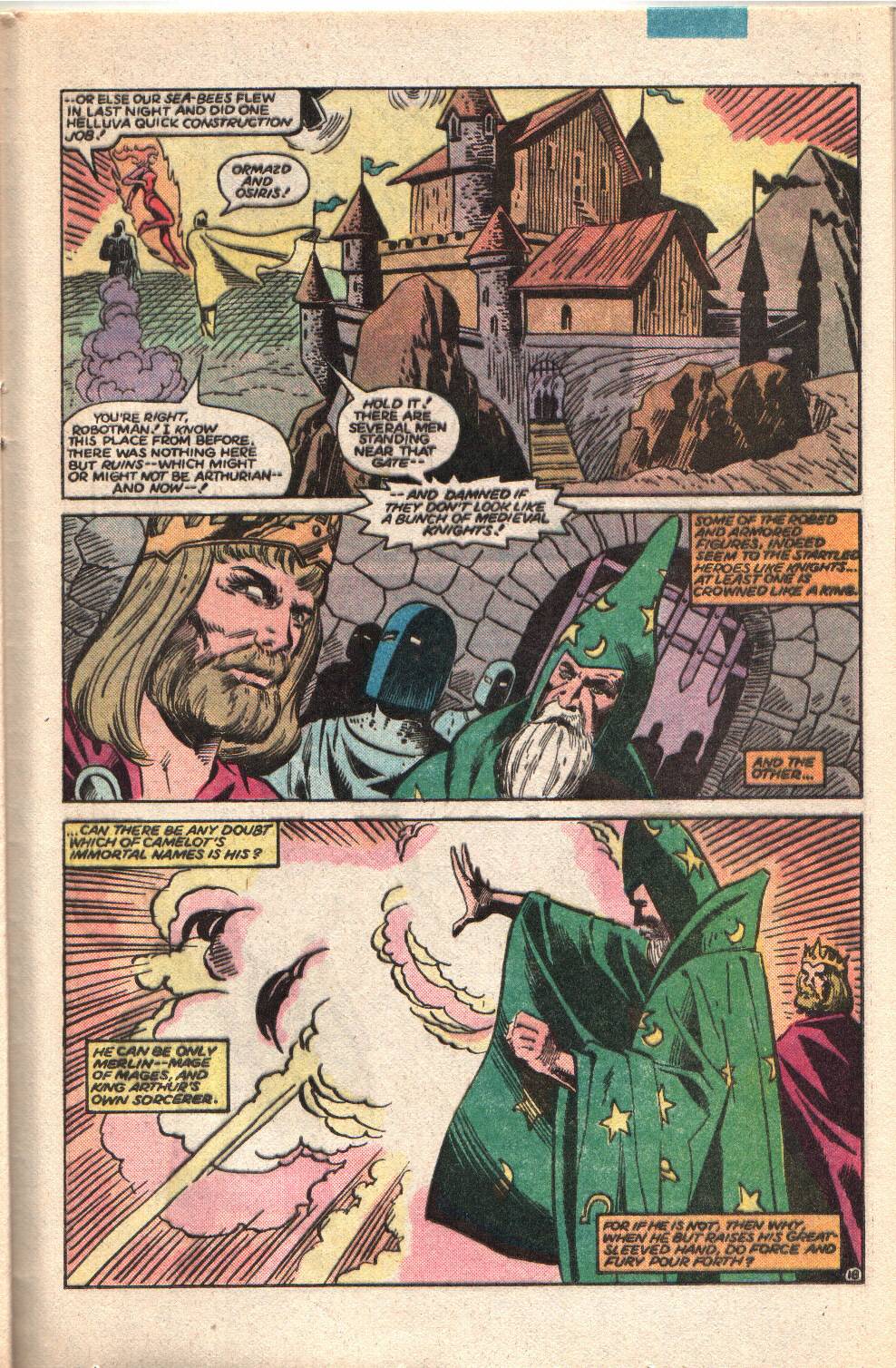 At said castle appears to be Arthur and Merlin......................or Rick Wakeman....  Merlin throws magic at them and Dr Fate steps in and belts Merlin in the mush and he explodes. On the ground, Arthur turns out to be Wotan! 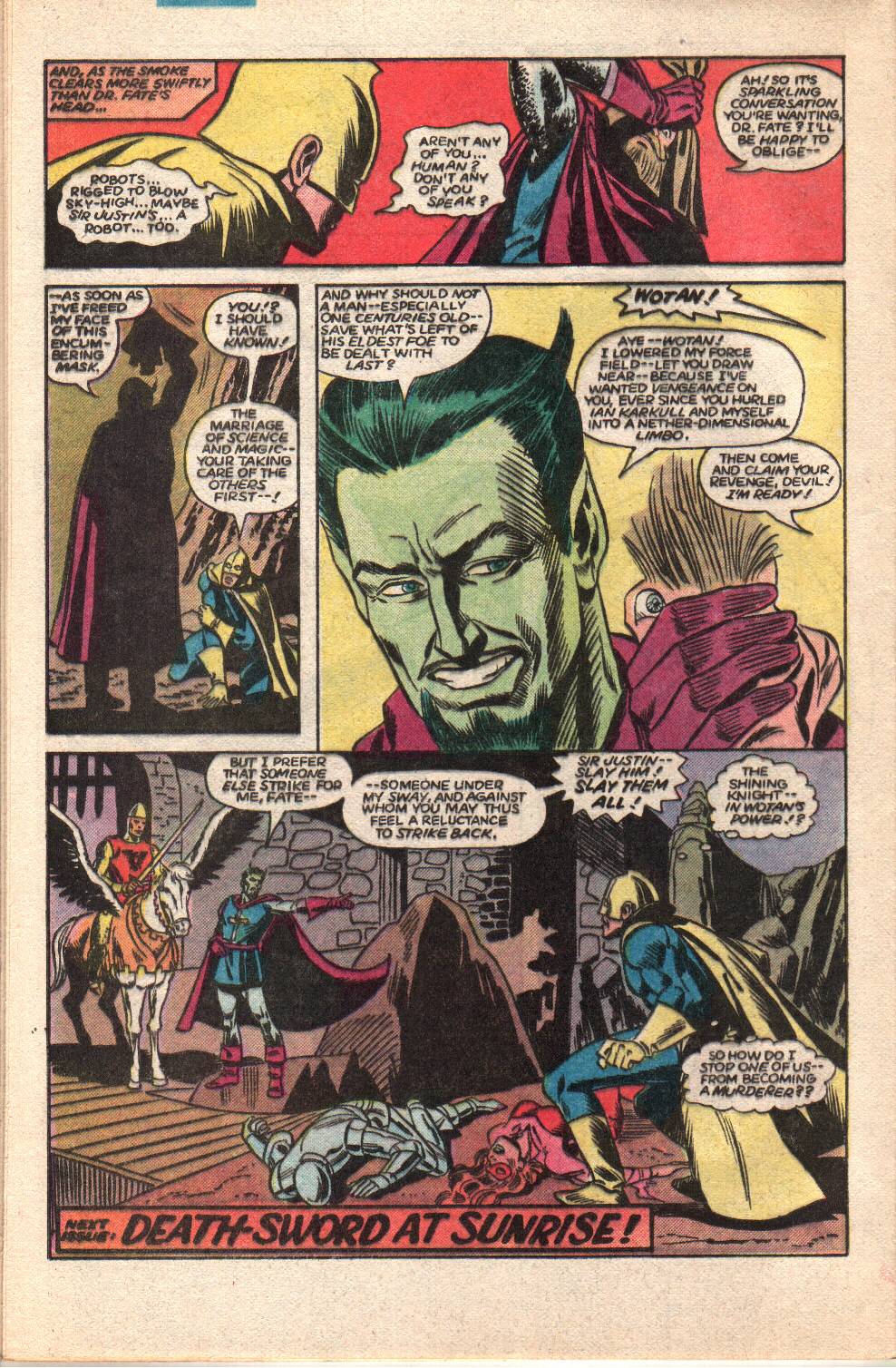 And Sir Justin is under his spell! Thoughts: Not too big of a surprise, given that Wotan was prominent in last issues Dr Fate origin story. The Camelot ruse is different. Nice to finally see the Blackhawks here, as they were one of the bestselling comics of the 1940s, with stories from William Woolfolk and Reed Crandall. Despite some poor aircraft, Mike Harris does a nice job here, especially with his faces. His Churchill is by far the best rendition yet, and all of the heroes get some great rendering that even Vince Coletta can't dampen. Harris worked a bit for Marvel, then DC and some of the indies, before moving over to computer games. He was also part of the National Guard and Army Reserve and became an officer and served two tours in Iraq and retired as a Lt Colonel!  That's a rather unique career path! He studied at the School of Visual Arts, under Eisner, Kurtzman, and others and JC Leyendecker was one of his influences and you can pick out some of that, here. Still, for someone whose wikipedia page says he was a weapons expert, his planes are pretty crappy. I'd say it was because he was a groundpounder; but, Kirby and Kubert were in the infantry and they could draw accurate aircraft. Granted, this was before his stint in the Guard and Reserves and long before combat; but, if the shoe fits. Needed better reference material, at least. As Roy notes on the splash page, DC was in the middle of publishing Mike Barr and Brian Bolland's Camelot 3000 and would still be publishing it after this, thanks to long delays in finishing the 12 issue maxi-series. Mike Clark provides pin-ups of Dr Mid-Nite, Wonder Woman and Green Lantern... 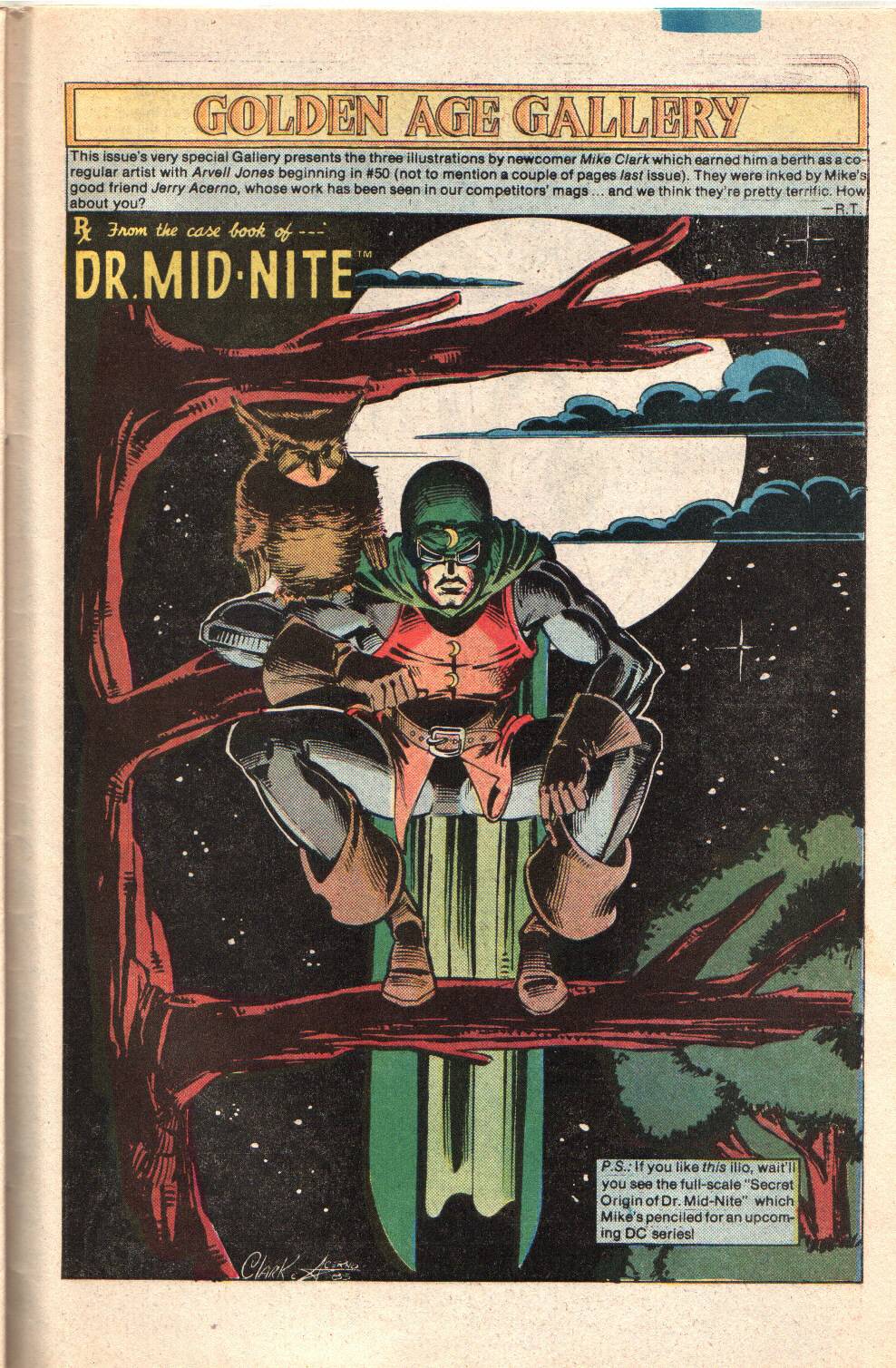 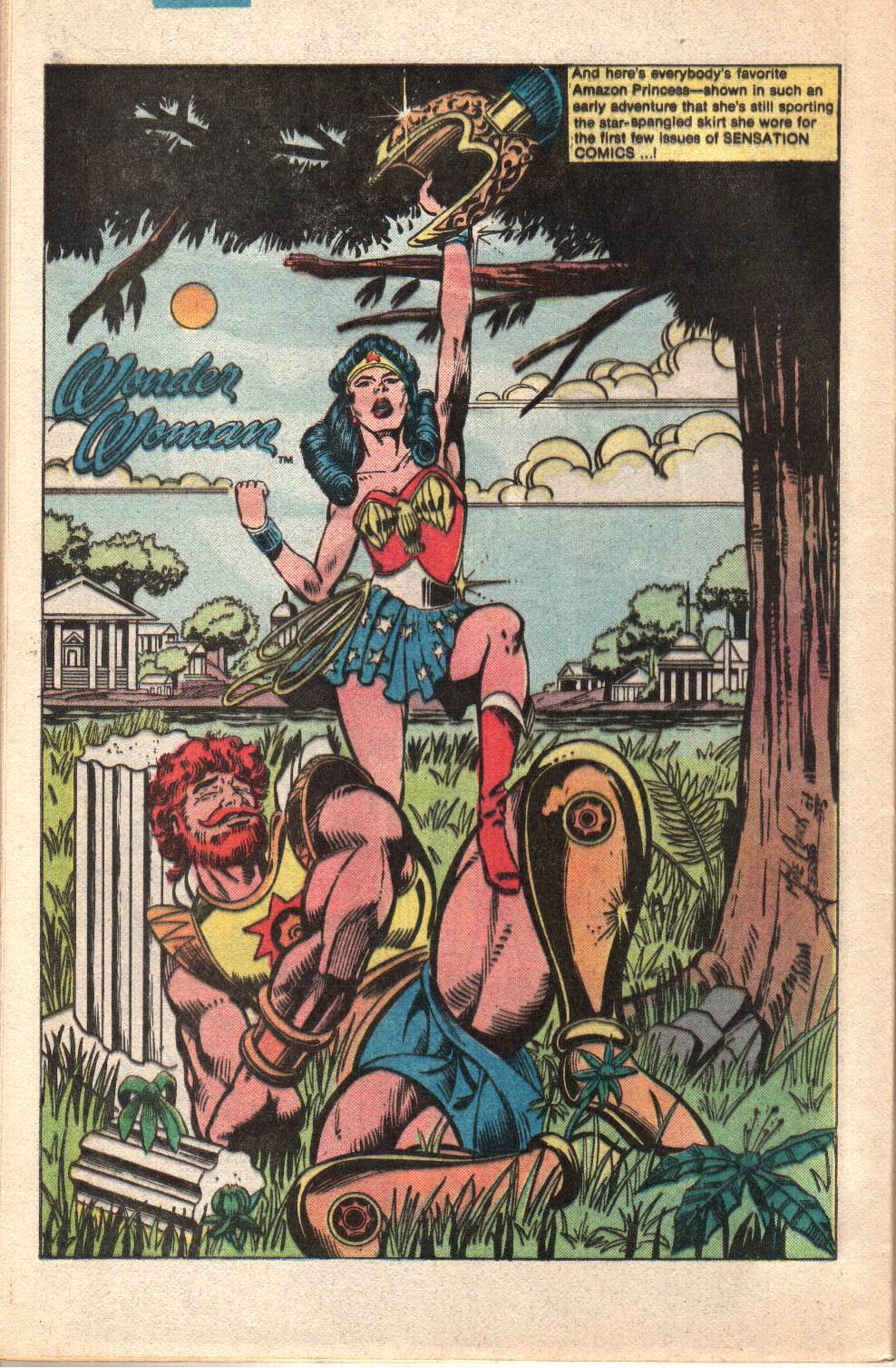 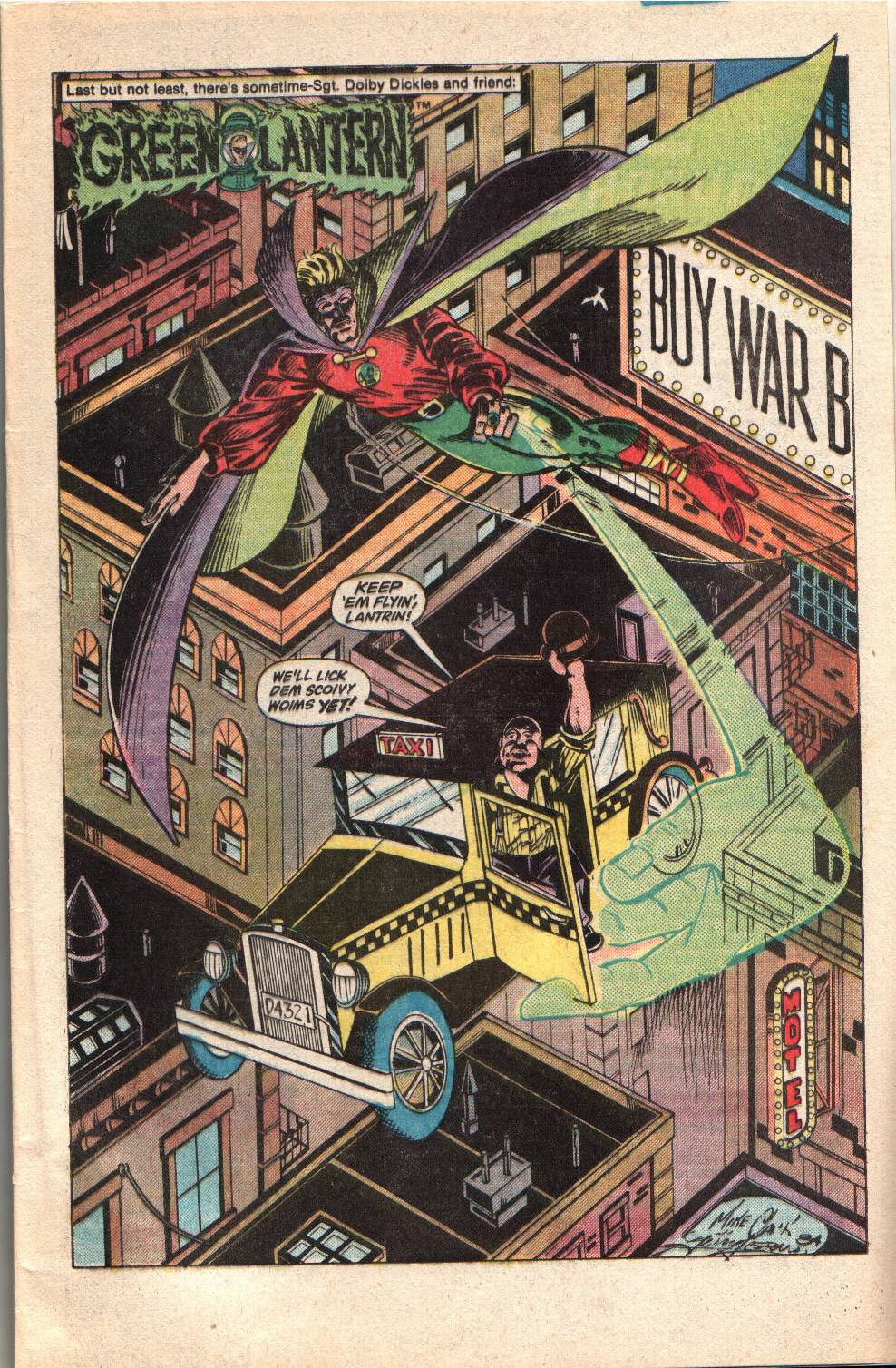 Wondy is a bit awkwardly posed, as her foot is on Hercules' (or whoever) inner thigh. Historical Notes Not much of real history in this issue, though, if Harris did intend thosde planes to be Dornier Do-17s, they should look more like this...  At least one panel looks a bit like a Junkers Ju-89... 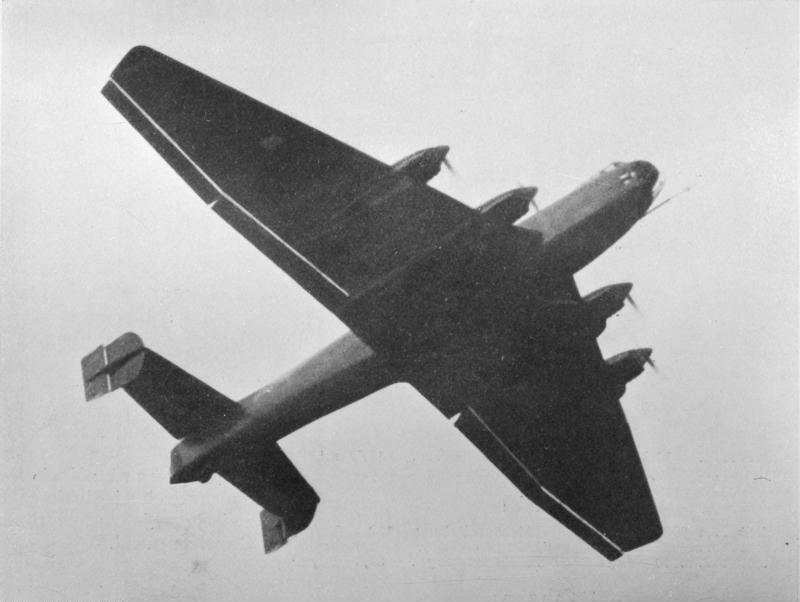 One thing was for sure, the Blackhawks are flying their Grumman XF-5 Skyrockets!  Before being made famous in the pages of Blackhawk, the Grumman XF-5 was a prototype built for the US Navy, as a twin-engine carrier-based fighter. The twin engines would give greater power and range and it was a revolutionary design. Initially, it had problems with engine cooling, which required modifications. It was flown in tests by the Navy and the pilots considered it a dream carrier plane, as the twin engines had counter-rotating propellers, which eliminated torque, during take off. The side mountings gave greater forward visibility, especially for carrier launch & landing, as the pilot could more easily see the Landing Signals Officer (LSO). In tests against other aircraft, it blew away both the F-4U Corsair and the Spitfire. However, spare parts and manufacturing difficulties related to the twin engines led to orders being placed, instead, for the Wildcat and the later Hellcat and Corsair. So, the XF-5 would have faded into obscurity, if not for Wil Eisner and Chuck Cuidera giving the plane to the Blackhawks, where they became iconic. Unfortunately, the fact that they never went beyond prototype stage meant that the Blackhawk serial had the team flying Beechcraft commercial planes. September 1943 The Allies begin the Invasion of Italy, which leads to the Italian surrender, almost immediately. The invasion had been tentative, as Gen Marshall and others in the US felt an invasion of Italy was a distraction from invading France and would require manpower better suited to those landings. Churchill pushed heavily for it, but the fall of Mussolini led to the eventual undertaking. The Italians had already made overtures for an armistace, with the rpeservation of Rome a condition. Allied plans involved multiple landings and airborne operations, to seize passes and airfields, as well as cut off German retreat. All of the initial airborne operations were called off. The first landings in Calabria met with no resistance and immediate surrender. The same was not true of the main landings, near Salerno, where they met heavy German and Fascist Italian resistance. The Allies succeeded in taking an airfield, but were still within German artillery range, rendering it useless. Landings were undertaken without pre-invasion shore bombardment, hoping for surprise, but landing craft were hailed by loudspeakers from the shore, before they were on the beaches, to find the German's well sited. Aircraft carriers had to remain on station to defend against Luftwaffe sorties, as they attacked the command ship, the USS Acnon. They even dropped the Fritz X glide bombs to attack the ships. The American invasion forces, and the Italian campaign, was under the command of General Mark Clark. Clark is a controversial figure in the military, as the Italian theater saw the highest casualty rates of the Western Front, with minimal gains to show for it. He was young for his rank, but was considered a fine staff officer by Eisenhower, which aided rapid promotion. Patton felt he was "too slick" and more concerned with himself (which is a bit rich, from Patton). He failed to press his advantage and decimate the German 10th Army, allowing them to escape, in violation of orders from Gen Alexander, his superior. The lnadings at Anzio would prove nearly disasterous and much blood was spilled advancing up the so-called "soft underbelly of Europe." After the Allies had landed, the population of Naples, over a 4-day period, with little armament, rose up against German occupiers and disrupted their plans to destroy the city. The scene would later be repeated in Paris. In relation to the invasion, following on the deposing of Mussolini, the Germans launched a daring airborne operation, led by Waffen SS Hauptsturmfuhrer Otto Skorzeny, 16 SS troopers and a larger fallschirmjagger contingent landed at Gran Sasso, in gliders, and overwhelmed the carabinieri guarding Mussolini. He was escorted out of the hotel, where he was held, and put on a Fiesler Fi-156 Storch light plane and flown to Vienna, then Wolf's Lair, where he was welcomed by Adolf Hitler. In the Pacific, the 503rd Parachute Regiment lands just east of Lae, on Papua New Guinea. This is later followed by amphibious landings, which include Australian troops, who carry out their first amphibious landing, since Gallipoli (and with greater success).
|
|
|
|
Post by dbutler69 on Oct 28, 2020 15:50:09 GMT -5
I thought #47 was so-so by All-Star Squadron standards. Nothing special in terms of writing or art, though certainly not bad, either.
I definitely liked #48 more. It was a quite good, but not great, All-Star Squadron issue, though we have Hourman feeling sorry for himself, of course. Because he's a superhero and this is a comic. Also, the Mike Harris art was good. I actually enjoyed it more than the McFarlane stuff from the issue before. McFarlane would go on to do a very good job on Infinity, Inc., though.
|
|
|
|
Post by codystarbuck on Oct 28, 2020 16:20:17 GMT -5
I thought #47 was so-so by All-Star Squadron standards. Nothing special in terms of writing or art, though certainly not bad, either. I definitely liked #48 more. It was a quite good, but not great, All-Star Squadron issue, though we have Hourman feeling sorry for himself, of course. Because he's a superhero and this is a comic. Also, the Mike Harris art was good. I actually enjoyed it more than the McFarlane stuff from the issue before. McFarlane would go on to do a very good job on Infinity, Inc., though. Harris is definitely the more technically sound of the two, with far more formal art training. His anatomy is far stronger, his storytelling a bit more advanced, and his knowledge of facial expressions much more developed. McFarlane is a good designer but, a fair storyteller. His strength was more in creating an interesting page than an interesting story. When he worked with a good writer, the results were far better than his own stories. Harris has a very classical feel, which really suits a period book, like this. |
|
|
|
Post by dbutler69 on Oct 29, 2020 10:31:38 GMT -5
I thought #47 was so-so by All-Star Squadron standards. Nothing special in terms of writing or art, though certainly not bad, either. I definitely liked #48 more. It was a quite good, but not great, All-Star Squadron issue, though we have Hourman feeling sorry for himself, of course. Because he's a superhero and this is a comic. Also, the Mike Harris art was good. I actually enjoyed it more than the McFarlane stuff from the issue before. McFarlane would go on to do a very good job on Infinity, Inc., though. Harris is definitely the more technically sound of the two, with far more formal art training. His anatomy is far stronger, his storytelling a bit more advanced, and his knowledge of facial expressions much more developed. McFarlane is a good designer but, a fair storyteller. His strength was more in creating an interesting page than an interesting story. When he worked with a good writer, the results were far better than his own stories. Harris has a very classical feel, which really suits a period book, like this. Yeah, in reading Infinity, Inc., McFarlane had some very interesting and original page layouts, but sometimes it was to the detriment of clarity and/or the storytelling. |
|
|
|
Post by codystarbuck on Nov 1, 2020 16:10:11 GMT -5
All-Star Squadron #49 Creative Team: Creative Team: Roy Thomas-writer/editor, Mike Harris-pencils, Vince Coletta-inks, Cody Weiss-letter, Carl Gafford-colors Synopsis: We pick up with Dr Fate facing Wotan and The Shining Knight, who is under his control... 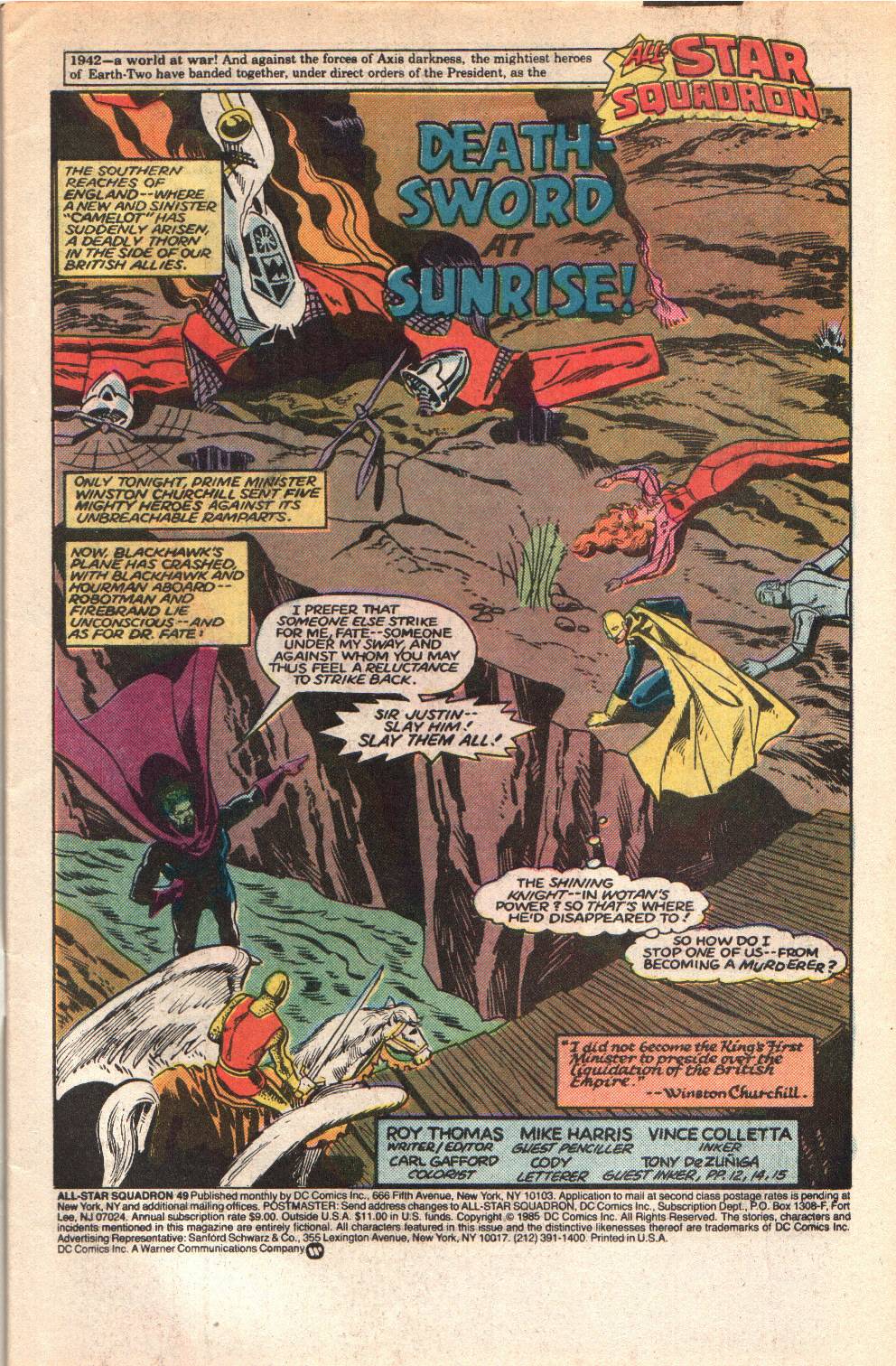 That image brings up a point that was never addressed, as far as I know, in the Blackhawk comics: where they got their spare parts and replacement planes. The Grumman Skyrocket was a prototype, not a production aircraft. Even the luckiest pilots who never get hit, still get damage to their planes, just from the stresses of constant flight, take-offs and landings, let alone combat. That means spare parts; but, even more, replacement aircraft after you have flown the hell out of what the plane has to give. William Rotsler, in the Blackhawk prose novel, actually addresses this, as the planes are specially manufactured for them, along with parts, by a sympathetic manufacturer, named Paul Levitz, as a nod to the DC writer and editor (and VP). He also placed Blackhawk Island in the Orkneys. Anyway.... Wotan sicks Sir Justin on Dr Fate, after some jaw-jacking, and Doc punches Winged Victory! Holy Mongo! 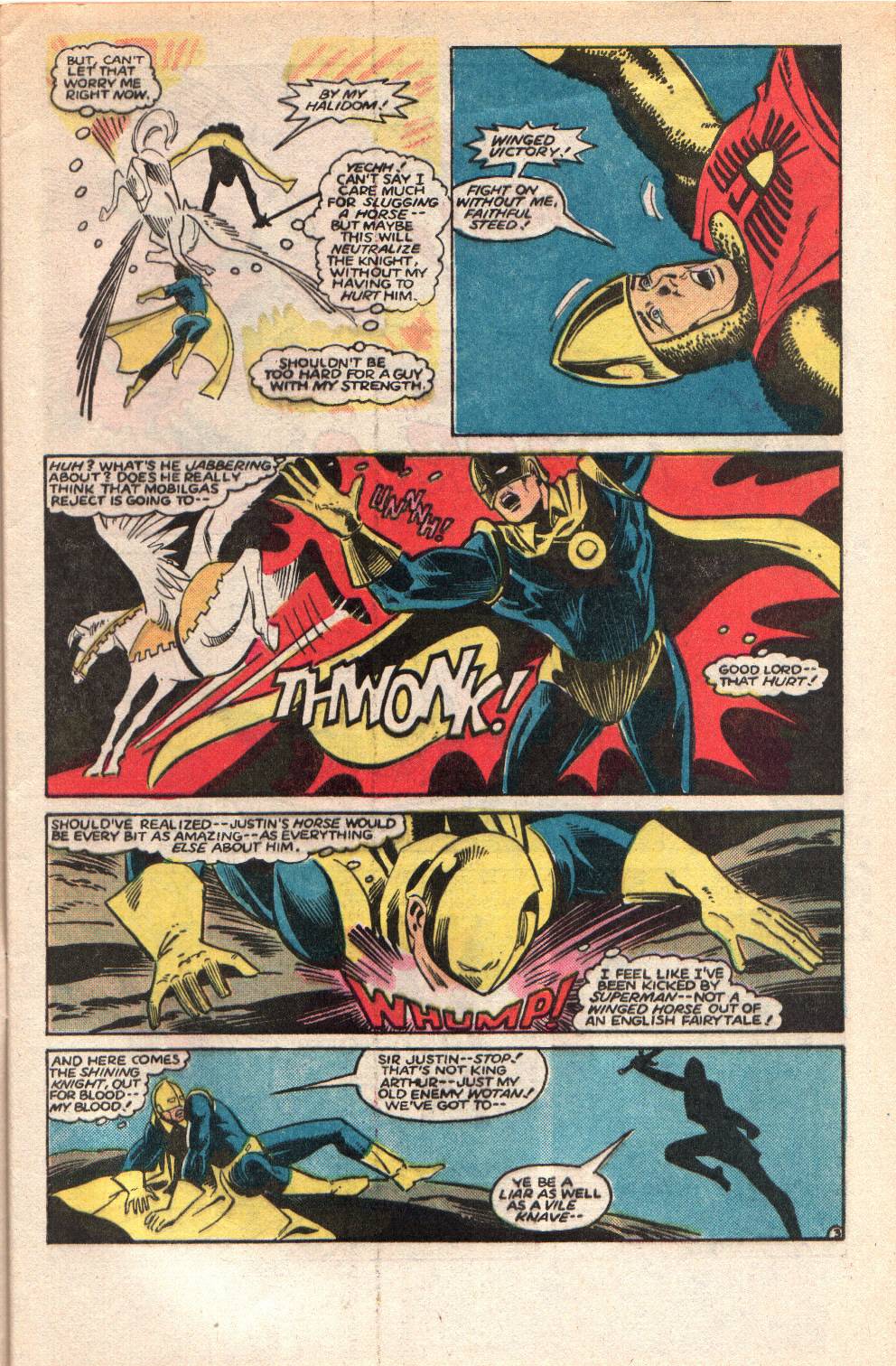  Winged Victory delivers a "receipt"... (Really great movie, even if you have no interest in pro wrestling; funny comedy, heartwarming, if bizarre family story, great actors. Original documentary that inspired it is really good, too.) Sir Justin hits him with his pigsticker and Fate is down and looking like he is fubar. By the way, Harris kind of has Sir Justin looking like Dirk Daring... 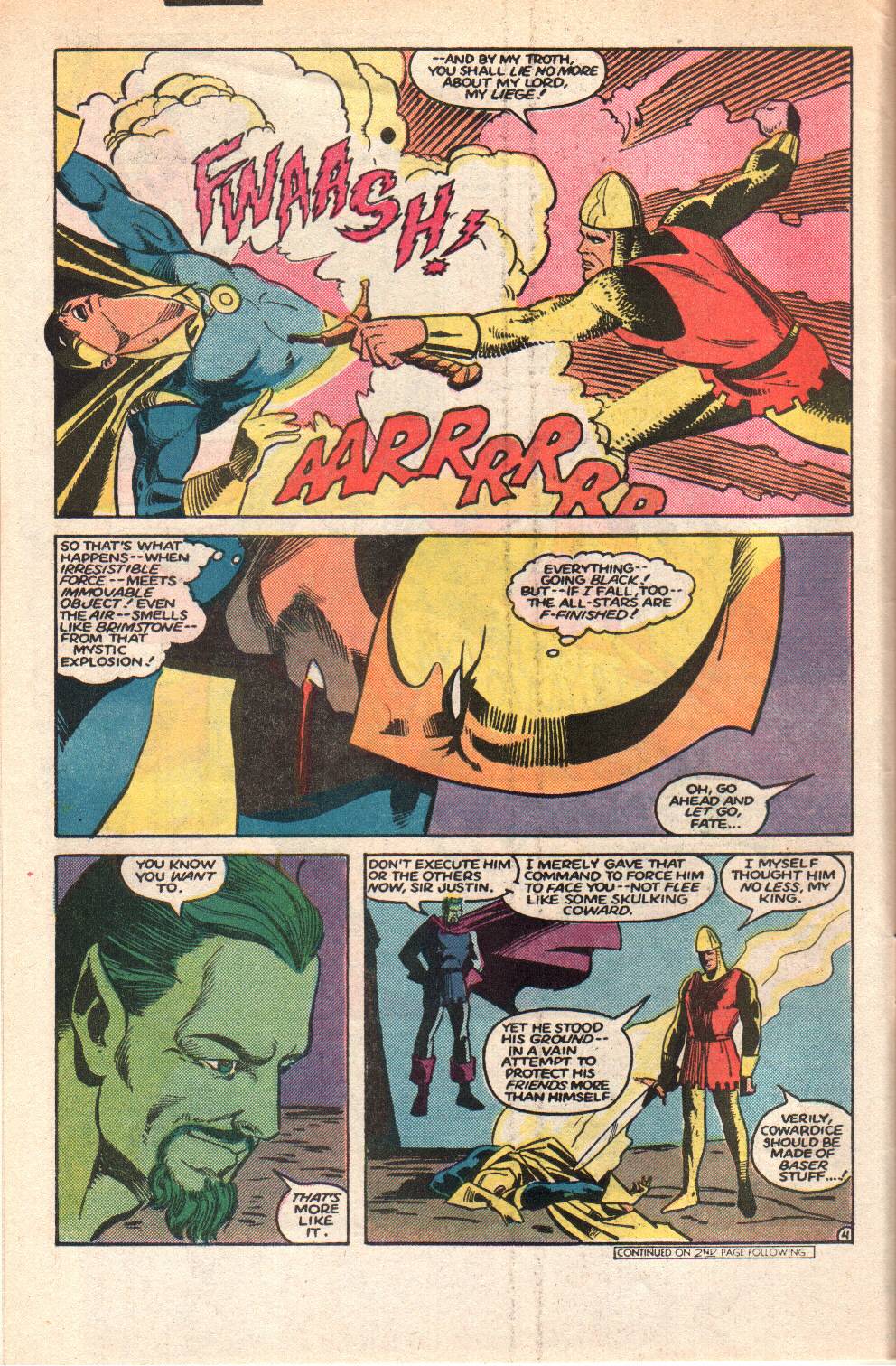 (top panel, mostly)  Wotan lets them live and has Sir Justin imprison them in a Wurlitzer juke box.... 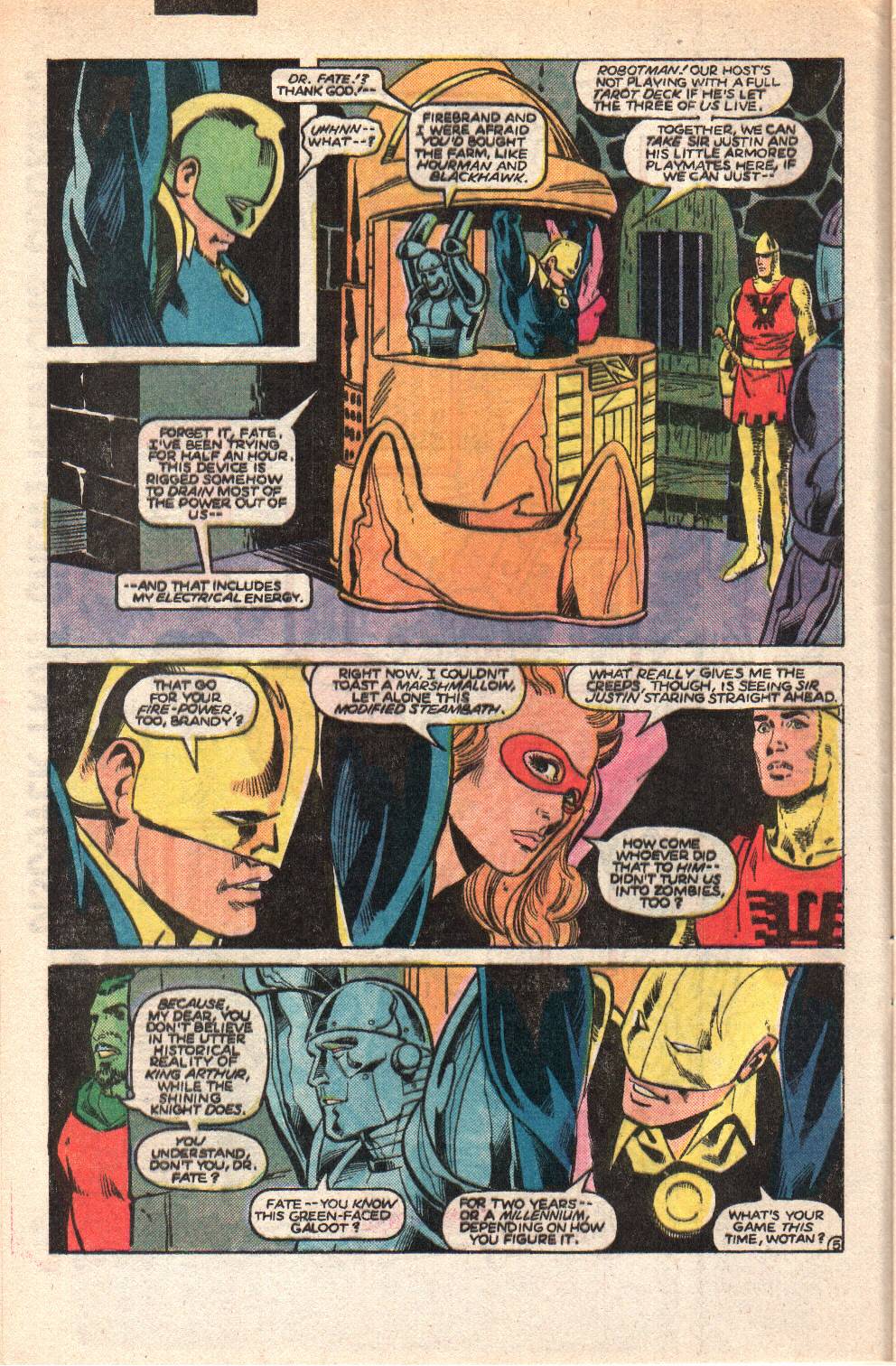 Wotan monologues, as Firebrand questions why only Sir Justin was under his spell, explaining that Sir Justin is tied to the place, which is the site of old Camelot. Wotan discovered it, after Dr Fate defeated he and Ian Karkull, in the netherworld (rescuing Inza) and had a new castle built, mystically disguised to appear as ruins. That is when another prisoner speaks out and it is Dr Occult, who goes over his resume... 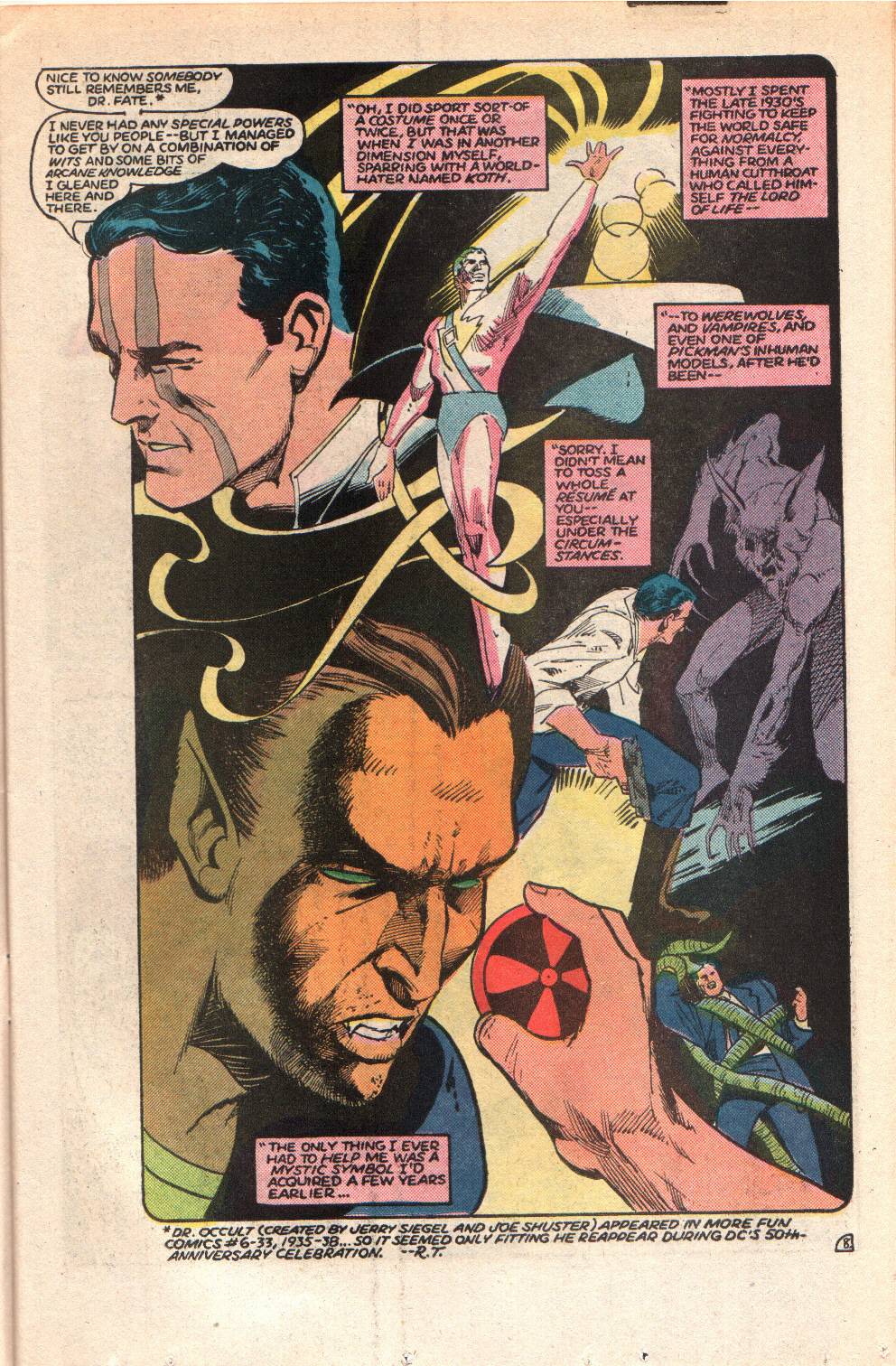 He was protected from Wotan's magic by his amulet; but, not his science. Wotan crows, then takes a call from his master (he says ally) Adolf Hitler, who gets a report and says do what he wants with the All-Stars. The plan is to send a robot "knight" army, led by the Shining Knight, to destroy British morale... 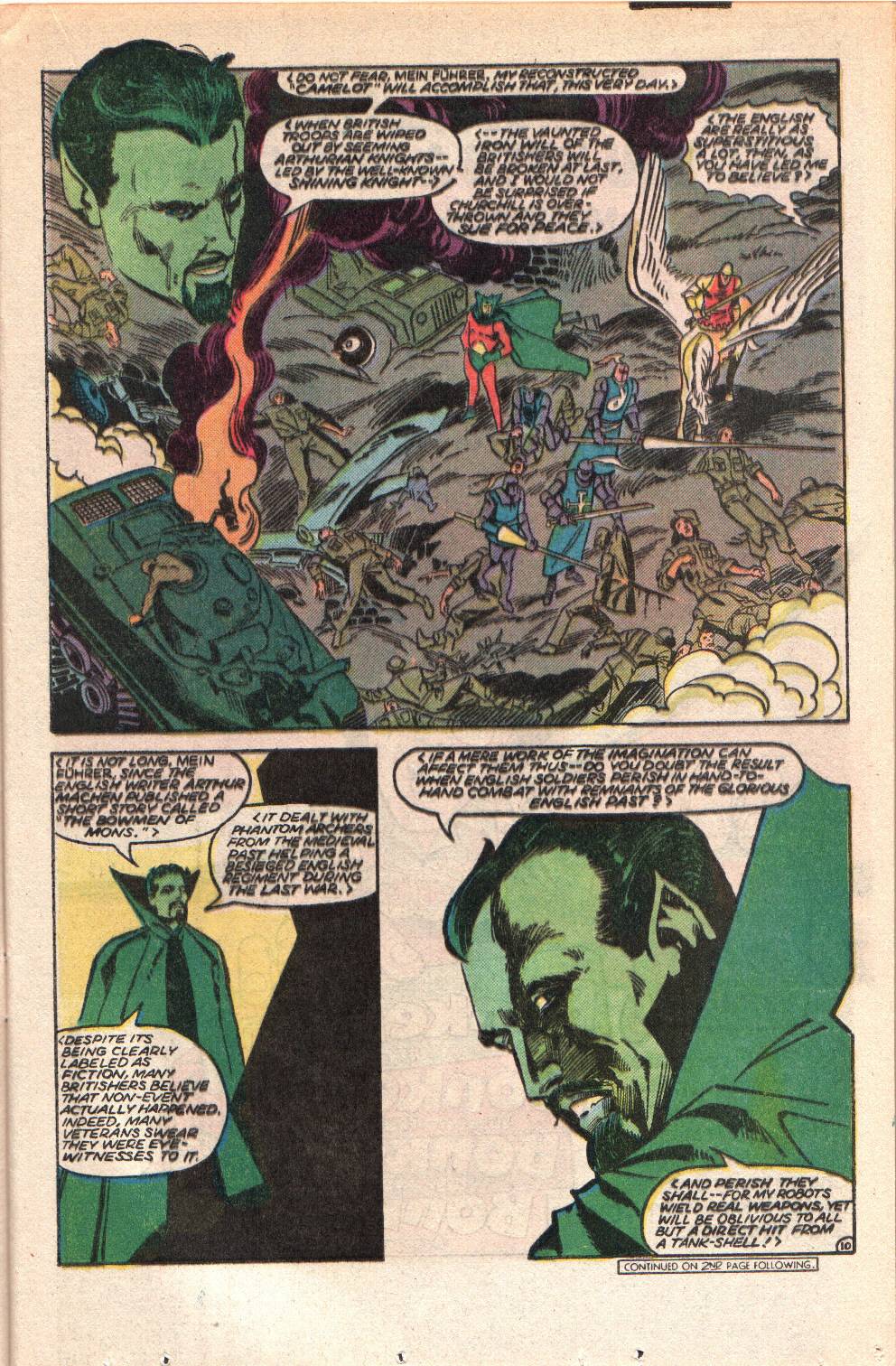 Hitler signs off and Wotan talks smack behind his back and name drops Lovecraftian gods (Roy is strutting his influences). he notes British army troops massed outside and it is showtime. The Tommies see the knights, the All-Stars in their Wurlitzer and the giant spectral face of King Arthur, which they immediately recognize, even though he is a legendary figure who was never portrayed the same by artists (he doesn't even look like Hal Foster's Arthur). So, they buy into this, as the knights attack and kick butt. Churchill gets radio reports and it sounds bad; but, he holds off sending in the RAF, for fear of a Nazi attack, with this as a diversion. Thinks are bad and a robot is about to strike down a helpless soldier, when help finally arrives... 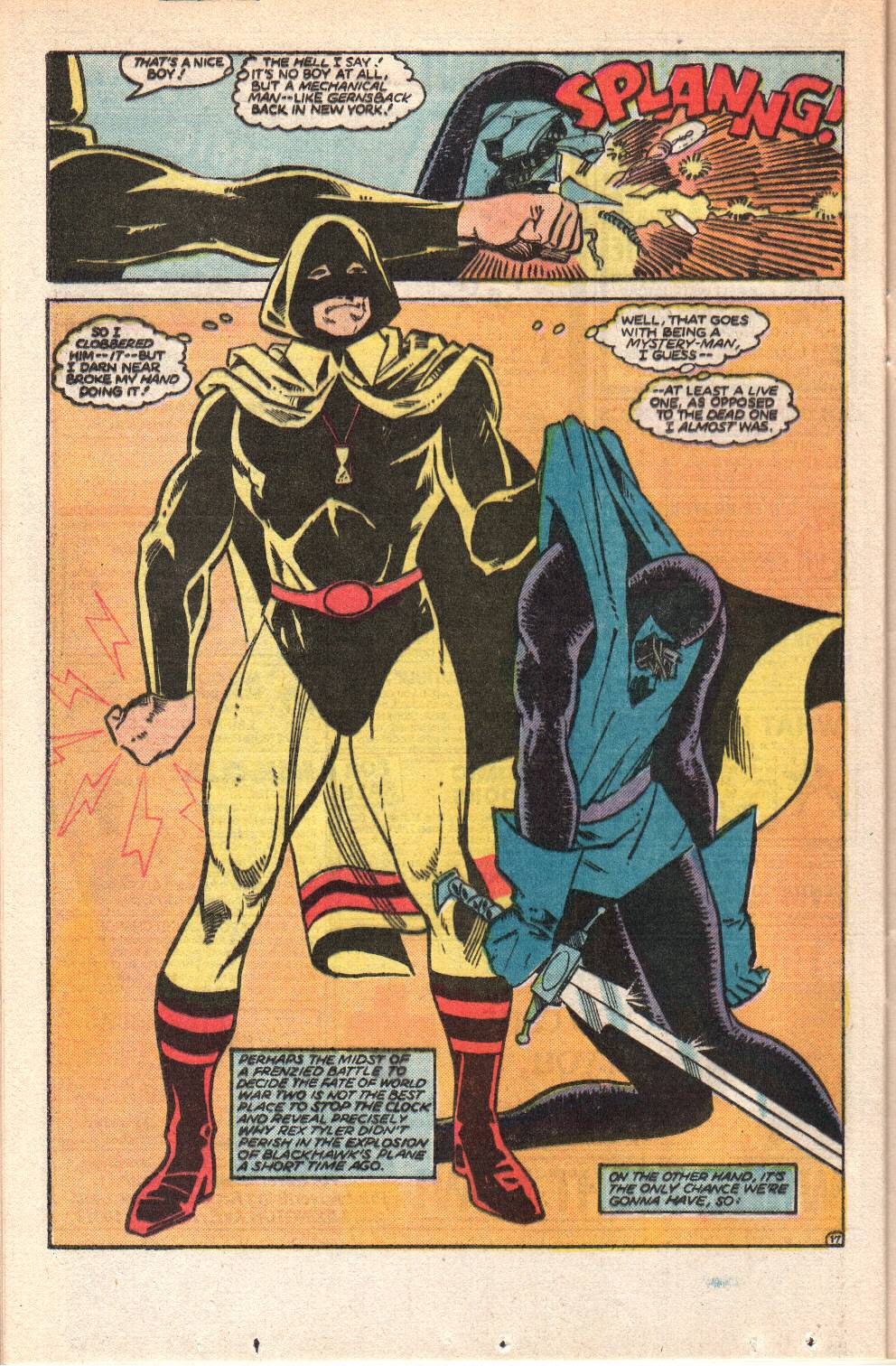 He used Miraclo to survive the crash with Blackhawk. He takes the fight to the robots and Sir Justin sees the nobility in his fighting and starts to waver. Hourman carries the Union Jack and the image finally breaks the spell and Sir Justin sees Wotan for who he is and turns babyface and decks Wotan. That breaks the other spells and the tide turns. On the battlefield, Hourman's time is up and the knight gains the advantage and Rex pops another Miraclo and wins, then falls face down, his pulse racing. Dr Fate rushes him to the hospital as we end, before Crisis intrudes upon things. Thoughts: Really good ending to a story that began rather bizarrely. Roy throws in Dr Occult, for no real reason other than to just have him around. Probably a set-up for Crisis, since one of the points of it was to celebrate DC's 50 year history, where Dr Occult was one of the earliest heroes, predating Superman, as Roy points out (including a proto-Superman costume, while having a Flash Gordon adventure). Mike Nelson's art continues to be a breath of fresh air, not that Arvell's was bad, quite the contrary: but, his classic style so perfectly fits the time period. Also, his expressive faces add a great deal to the storytelling. Wotan also brings a more powerful foe to the table, necessitating a team to stop him, compared to some of the other threats. Historical Notes: We are still in 1942 and Hitler is crowing about how he and his allies will destroy the USSR, but Stalingrad and Moscow stood fast. Camelot is mostly medieval legend, concocted out of later ideas; but, the Arthurian stories draw from a lot of earlier myth and where myth ends and truth begins is something that will probably never be conclusively answered. I still think, given the era of the story, that Camelot and Arthur should have looked like Hal Foster's Prince Valiant. October 1943 Naples is liberated, following the popular uprising. The new Italian government declares war on Germany. Canadian troops defeat the German falschirmjagger at the Battle of Ortona. In Greece, the Wehrmacht's 1st Mountain Division targets the village of Lyngiades for reprisal, after the death of an officer, at the hands of the Greek Resistance. They rounded up the population, divided them up into smaller groups and herded them into cellars and machine gunned them and set fire to the buildings. They killed 92, with only 5 survivors, almost all women, children and the elderly. In September, Z Special Unit (later called Z Force), a special operations unit, comprised of British SOE and Australian soldiers, carried out Operation Jaywick, where they sailed a disguised fishing boat into Singapore harbor and commandos attached limpet mines to Japanese ships, sinking 7 of them. In October, the Japanese rounded up and tortured around 50 civilians and internees, for alleged involvement. In air operations, the British deliver a devastating strike at Kassal, a key industrial city, killing some 10,000 and leaving another 150,000 homeless. Fires generated by the bombing raged for 7 days. The US 8th Air Force was not as successful and a second raid on Schweinfurt resulted in losses of nearly 26% of the attacking force. Fighter escort was only for the outbound and return legs of the flight, leaving the bombers alone over Germany, where they fell prey to the Luftwaffe and anti-aircraft batteries. 291 planes took part in the raid, with the entire force centered on Schweinfurt (after lessons of the first raid on the city), of which 6o were destroyed outright, 17 suffered enough damage that they had to be scrapped, and 121 had various degrees of battle damage. 22% of the bomber crews were lost. The targets were ball bearing manufacturing plants, which was heavily criticized by British Bomber Command as being inflated, in terms of importance, tot he German war effort. in fact, the Germans had large stockpiles of ball bearings, so the disruptions that did occur were minimal on weapons production. The losses were staggering and major operations could not be mounted until forces were rebuilt. The 8th Air Force was gaining experience at the very high cost of machinery and human lives, as casualties were staggering. As a result, daylight unescorted raids were suspended, until February 1944, by which time P-51 Mustang squadrons were available for fighter escort for the entire mission (using drop tanks). On October 16, 1000 Jews, in the Ghetto of Rome, are rounded up by the Gestapo and deported to Auschwitz. Only 15 would survive the war. Pope Pius XII remained silent during the roundup, which has been the subject of controversy surrounding him and the role of the Catholic Church, during the war, since then. Italy had nor formal persecution policy and the matter only came about with the Allied invasion. There were Catholic networks that sheltered escaping Jews, even within the Vatican, but research has shown that it was more of an ad hoc system, not something managed from the Vatican or a formal policy. It was felt that a public outcry by the Pope would have stopped the German actions and the Germans actually expected such to occur; but, when it did not, they carried out the operation without hesitation. On October 14, members of the Underground, inside Sobibor concentration camp, began covertly killing SS officers, setting off an uprising. Word of the destruction at Belzec had spurred on a resistance movement, which was greatly aided by the presence of Russian soldiers who were used as forced labor nearby. The Russians included Alexander Perchersky, a political commisar and actor, who displayed disobedience, in shrewd manenrs, to the SS guards. He was approached and watched by the Underground and they combined forces and enacted a plan to isolate and kill key officers and non-coms, steal their weapons, and then gain access to additional weapons and take control of the camp and escape. Pechersky told them not to expect help from partisans, as they would need to do this themselves, which added resolve to the group. They succeeded in gaining weapons and overwhelmed enough guards that they were able to swarm the main gate and some 300 prisoners escaped. The SS killed the remaining 159 after retaking control. Some 59 escapes were captured and killed near the town of Sobibor, with more discovered and killed in other areas. 107 were killed or died due to other causes, before the end of the war. 58 were known to have survived. The camp was ordered dismantled, with labor from Treblinka used to accomplish it, upon which they were then shot and killed. The escape was dramatized in both the mini-series Holocaust, where Rudy Weiss (Joseph Bottoms), takes part in the uprising and is among the survivors); and, in the tv move Escape from Sobibor, starring Alan Arkin and Rutger Hauer, as Pechersky. There is also the Russian movie, Sobibor, and the documentary October 14, 1943, 4:00 pm.
|
|
|
|
Post by codystarbuck on Nov 1, 2020 16:19:49 GMT -5
ps the Letters pages have a lot of Roy talking about Dr Occult, feedback on Starman's origin and Roy's rationale for his story, and a suggestion from Lou Mougin, that they could link The Silent Knight to Clark Kent, as he was Brian Kent, and could have been a family ancestor. Mougin would later write intros to Airboy and Hillman Comics, for the launch of Eclipse's Airboy revival. Roy then tells us what's up for issue 50, which includes Firebrand being taken by Harbinger for the gathering in Crisis #1. Get read for a lot of red backgrounds!
|
|
|
|
Post by mikelmidnight on Nov 2, 2020 12:30:17 GMT -5
He also placed Blackhawk Island in the Orkneys. There were numerous Blackhawk Islands over the years. But when I did a fanfic series based in the United Kingdom, and one of my team members was Baker (the VERY obscure British member of the 'hawks), I used that as an excuse to have my team take over their abandoned base in the Orkney Islands. |
|
|
|
Post by dbutler69 on Nov 5, 2020 16:49:44 GMT -5
I thought #49 was a pretty good issue overall, though I find it surprising that the All-Stars don't seem to believe in a historical Arthur, even though Sir Justin, a member of King Arthur's court, is a teammate of theirs. Do they think Sir Justin is lying about King Arthur?
I agree that Wotan is worthy ASS (pardon the acronym) opponent.
And while I like the Mike Harris art, I wouldn't say I like it any better than Arvell Jones.
|
|
|
|
Post by codystarbuck on Nov 5, 2020 22:47:04 GMT -5
I thought #49 was a pretty good issue overall, though I find it surprising that the All-Stars don't seem to believe in a historical Arthur, even though Sir Justin, a member of King Arthur's court, is a teammate of theirs. Do they think Sir Justin is lying about King Arthur? I agree that Wotan is worthy ASS (pardon the acronym) opponent. And while I like the Mike Harris art, I wouldn't say I like it any better than Arvell Jones. I don't mean to say I like it better than Arvell Jones; I just feel it has a classic quality that is a stronger fit to the time period. The All-Stars may just be humoring Sir Justin about being a Knight of the Round Table. Really, I think it is more accurate to say they don't believe that Arthur has reappeared, so Wotan's spell doesn't work on them. I don't consider Wotan to be a reliable source on why his spell doesn't work on them, though Roy could have been clearer on that point. We will have to see if someone brings it up in the letters page, for Roy to answer. |
|
|
|
Post by codystarbuck on Nov 14, 2020 16:15:58 GMT -5
All-Star Squadron #50 Harbinger is the perfect figure for the cover, as her appearance really is that of a harbinger of doom. For the future of this book and the JSA. So, have fun! Creative Team: Roy Thomas-writer/editor and probably wishes he had been less cooperative, Mike Clark-pencils (pg 1-10), Arvell Jones-pencils (pg 11-38), Vince Coletta & Tony DeZuniga-inks, Cody Weiss-letters, Carl Gafford-colors Synopsis: April, 1942......Hey, we got through March a hell of a lot faster than January or February! Hawkman is on his way to the JSA meeting and his thought balloons recap the events of the war, at that point (the St Nazaire Raid, convoys reaching Russia, the Philippines)... 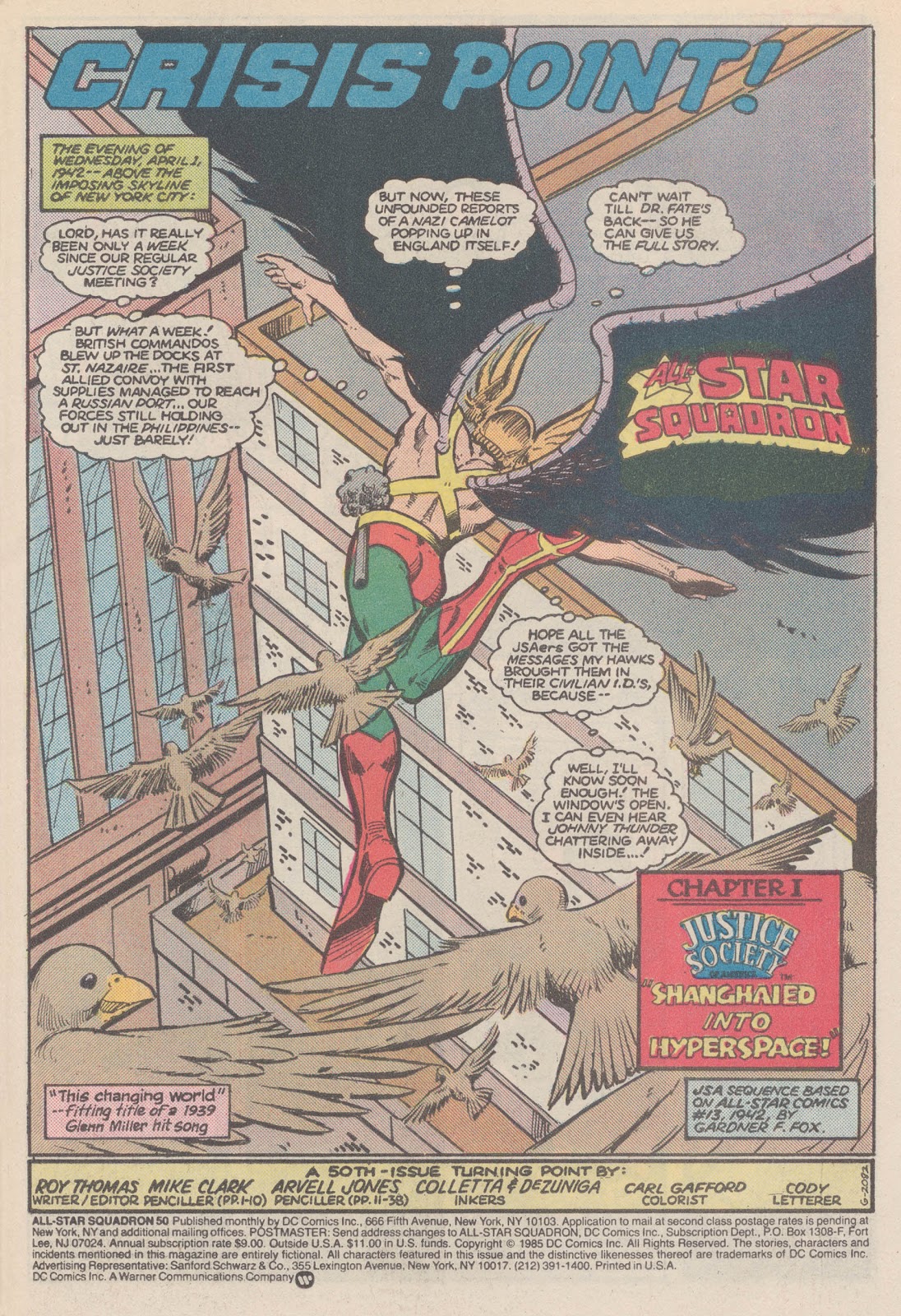 The gang is present, except Dr Fate (in England) and Hawkman calls the meeting to order. Johnny Thunder wants a pastrami on rye. Hawk says the government wants them ready for potential sabotage action, as the nazis are about to launch an offensive on the eastern Front. meanwhile, some Ratzis have broken into the building where the JSA meets and have set up something to lock them in and suck out all of the oxygen... 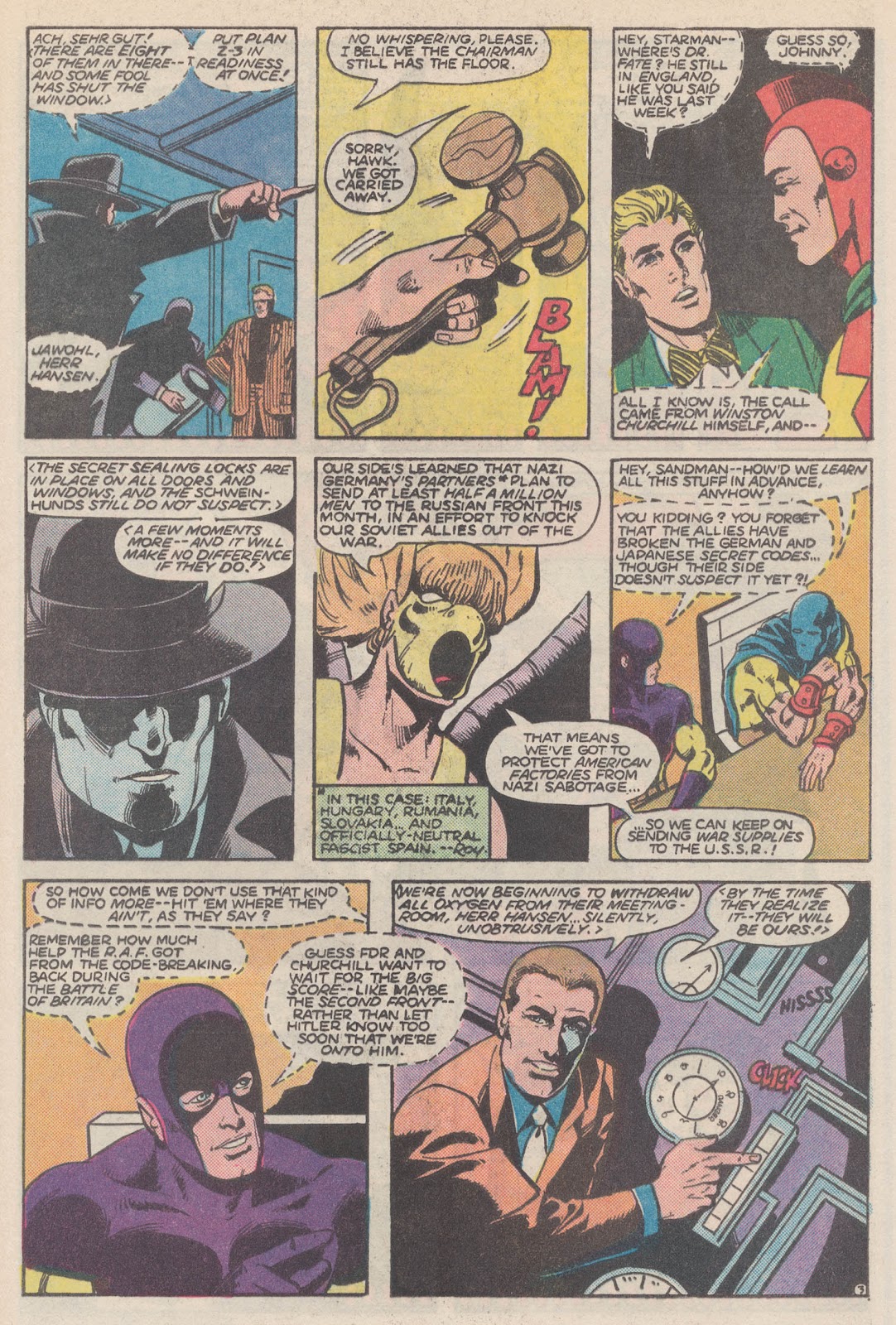 They all fall down, go boom, including Spectre, who wastes a lot of verbiage questioning how that can happen, since he is a dead man. Plot convenience? The Ratzis enter, wearing pseudo-diving helmets (with no visible oxygen supply) and "Ser gut" a lot. One of the lower ranks questions why they don't just put a bullet in each hero's head and, as usual, no one listens to "that guy." They scoop them up to cart them away. They hop into a Mayer Moving truck (Favorite movers of Ma Hunkel!) and head for New Jersey and a "rocket farm!" Awaiting them there is Engineer Gootsden, the Nazi scientist who F-d with Captain Marvel. He details his plans to rocket the JSA into space, so that the Axis Powers can win the war and "Rule ze vorld!"  Then, Harbinger turns up in space, revealing that the Monitor provided the rockets (Von Braun and his team wouldn't test their weapons for another year). her presence sends out waves of energy that affects events and they reach berlin, where CDR Steel is attempting to sneak into the Reich Chancellery. 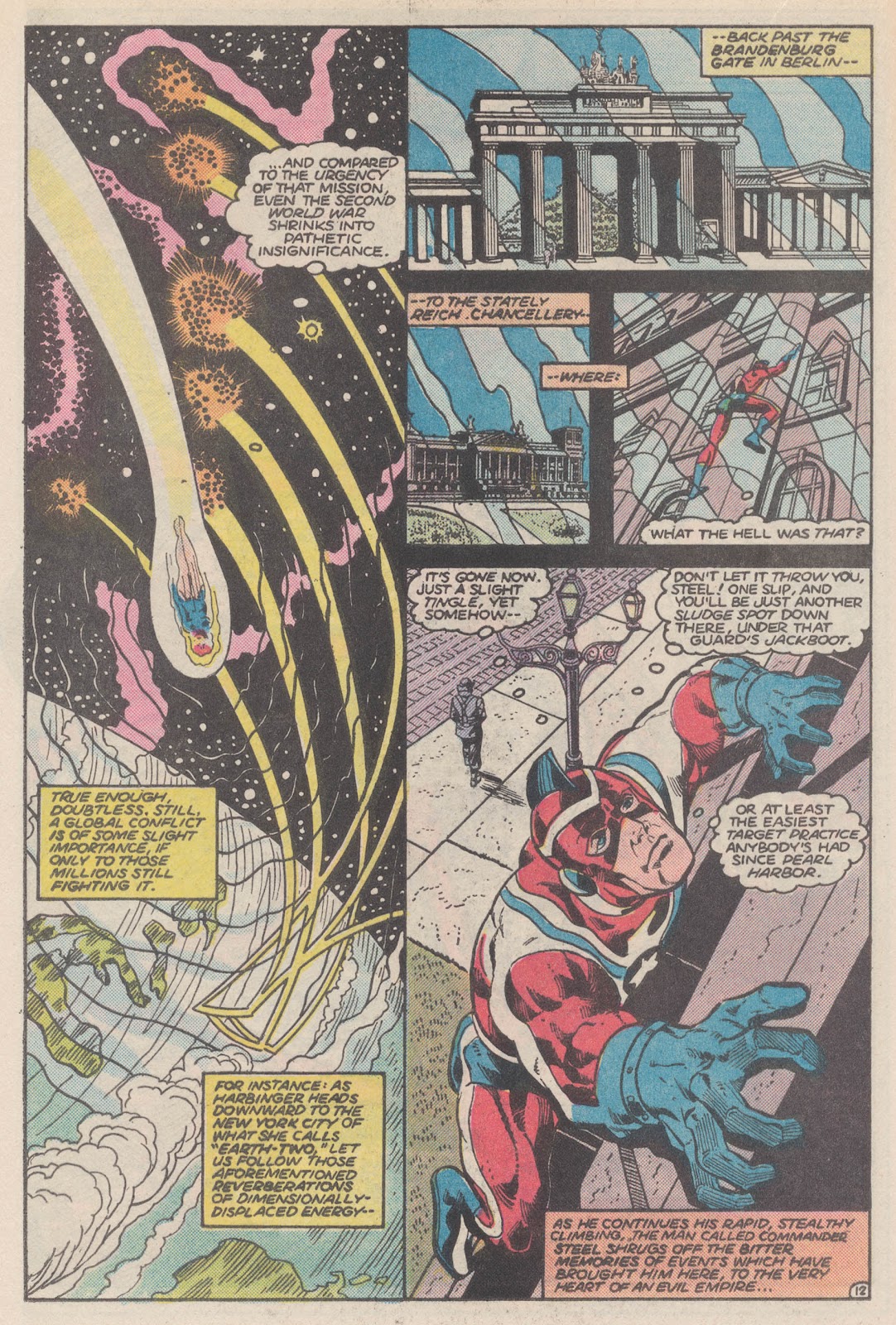 Note the stealthy red, white and blue clothing! He recaps his conversation with Gloria, that her hubby, Captain Farley, has been captured by the Nazis. they think he knows about her father's research. Steel sees the goons with Fairley and then busts in to do his Captain America bit, but gets a rifle butt to the head and goes down like a b@#$%. Meanwhile, at Madison Square Garden, Mayor Fiorello LaGuardia introduces the All-Star Squadron at a War Bond Rally and possible championship wrestling match... 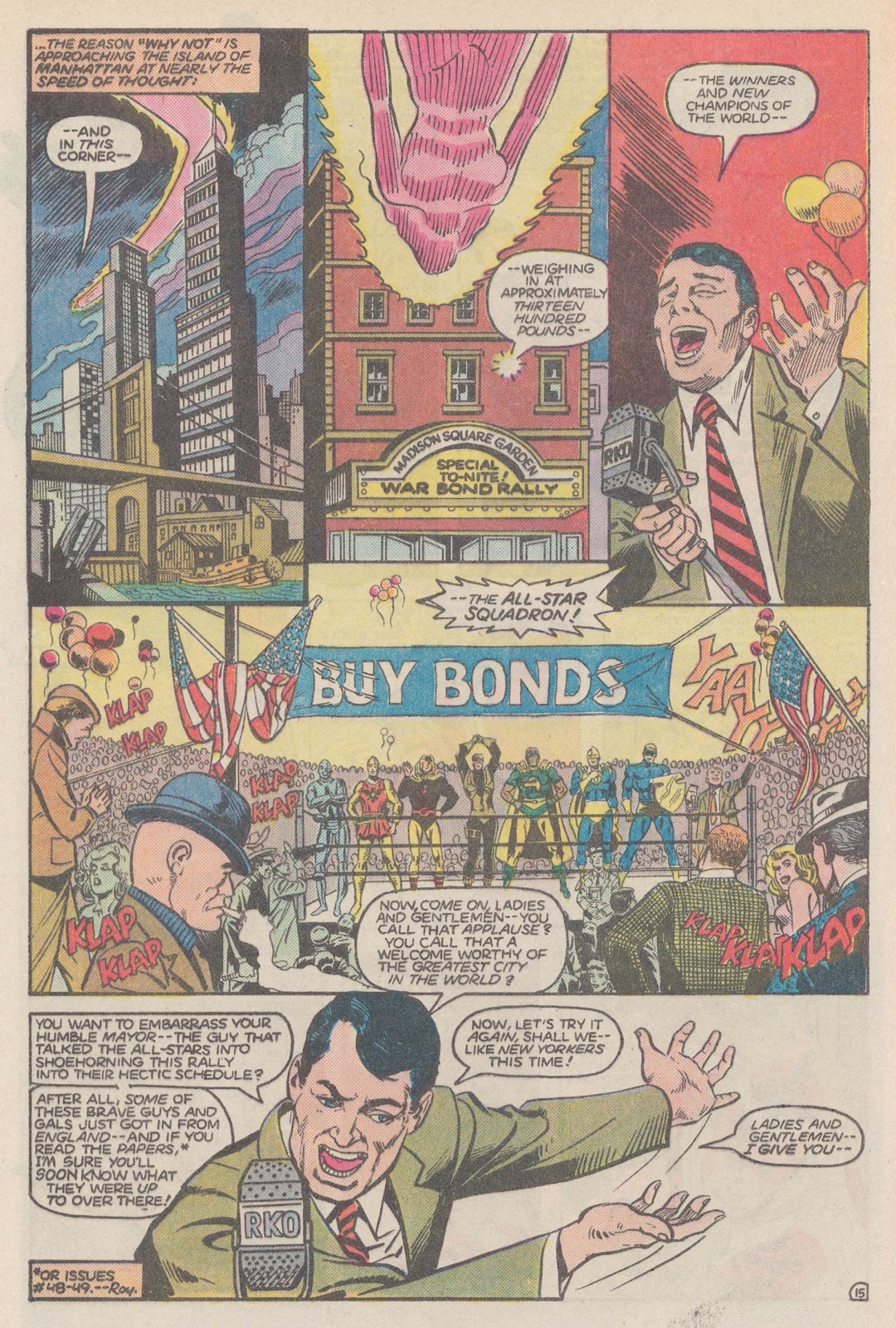 I think that's Toots Mondt, in the bowler hat!  Maybe not. Danette and Sandra Knight man the bond booth, with Ens Rod Reilly there, in a uniform that didn't exist (white uniform, but with a white double breasted jacket, not the "choker white" blouse of the Service Dress Whites). He also wears shoulder boards and collar insignia. More on this later. Rod is itching to return as firebrand and Danette says she is cool with that and makes fun of his costume, which she says is a bit of an issue for her (since she has to wear a leotard underneath it); but, she secretly thinks that she isn't giving up being Firebrand, no matter what big brother wants. Some a-hole in the crowd wonders what the "black boy" is doing with the All-Stars and Amazing Man thinks coming was a bad idea; but, Dr Fate tells him to hang tough. Easy for you to say paleface. We see Dr Occult there, too, back from England and captivity. Hourman has been healed by Dr Fate's magic, after a heart attack, brought on by a Miraclo OD. Sandra dances with Dr Occult. Sir Justin is also back, signing autographs (Keepeth them flying, Tummy!) Danette lights a stove with her flame. Dr Osgood Armsby's (Dr Occult) magic talisman glows and Harbinger turns up to whisk Danette away. 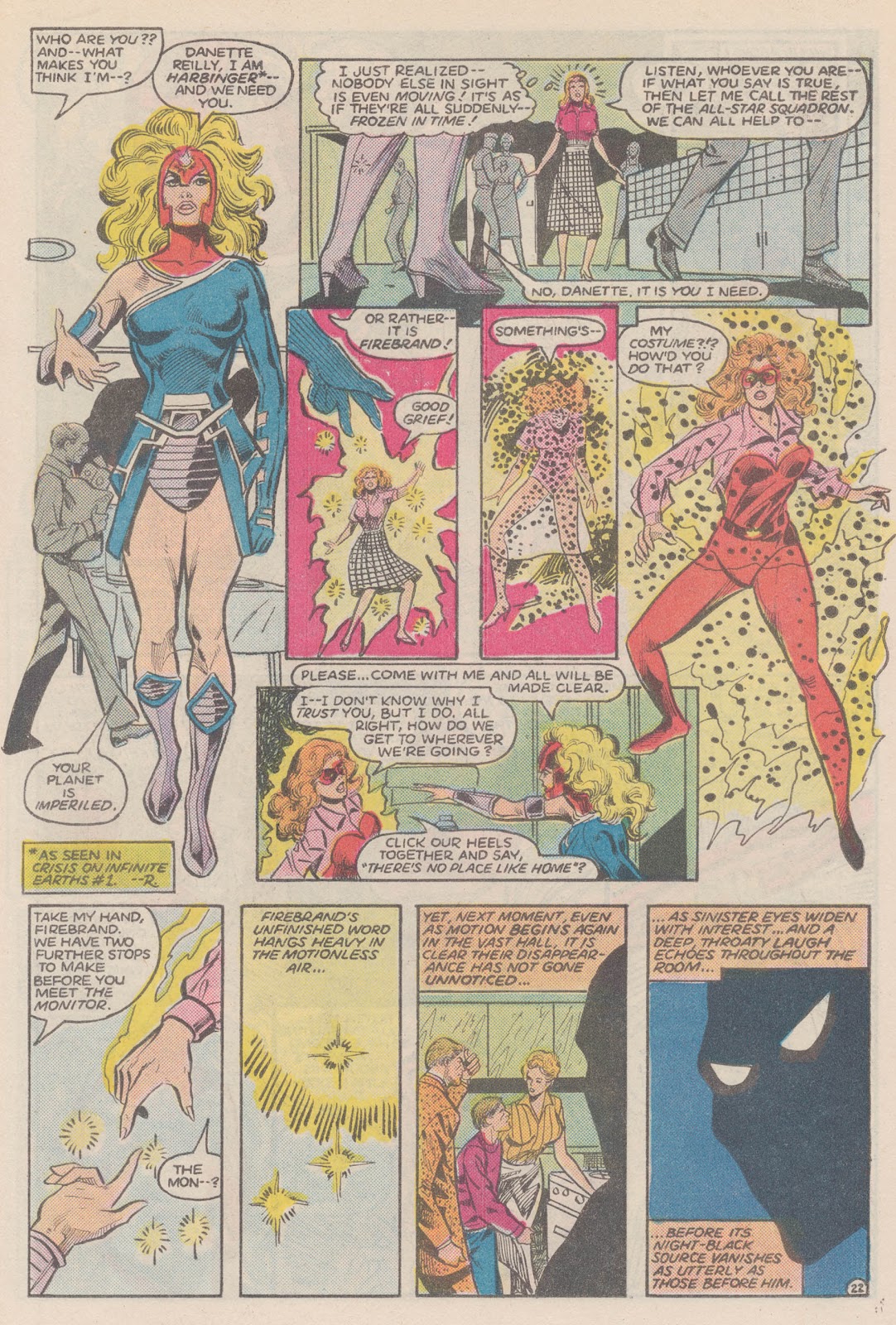 They run into a barrier, caused by the Nazis messing about with the Monitor's tech. harbinger sends a feedback wave to them and electrocutes the head Nazi and Steel busts some heads. then, he and the dead goosestepper disappear in an energy bubble. Fairley escapes. In New York, Rod alerts the All-Stars that Danette has disappeared, literally. They chase after her, after Sandra Knight stops to change into her costume, in front of Plastic Man... 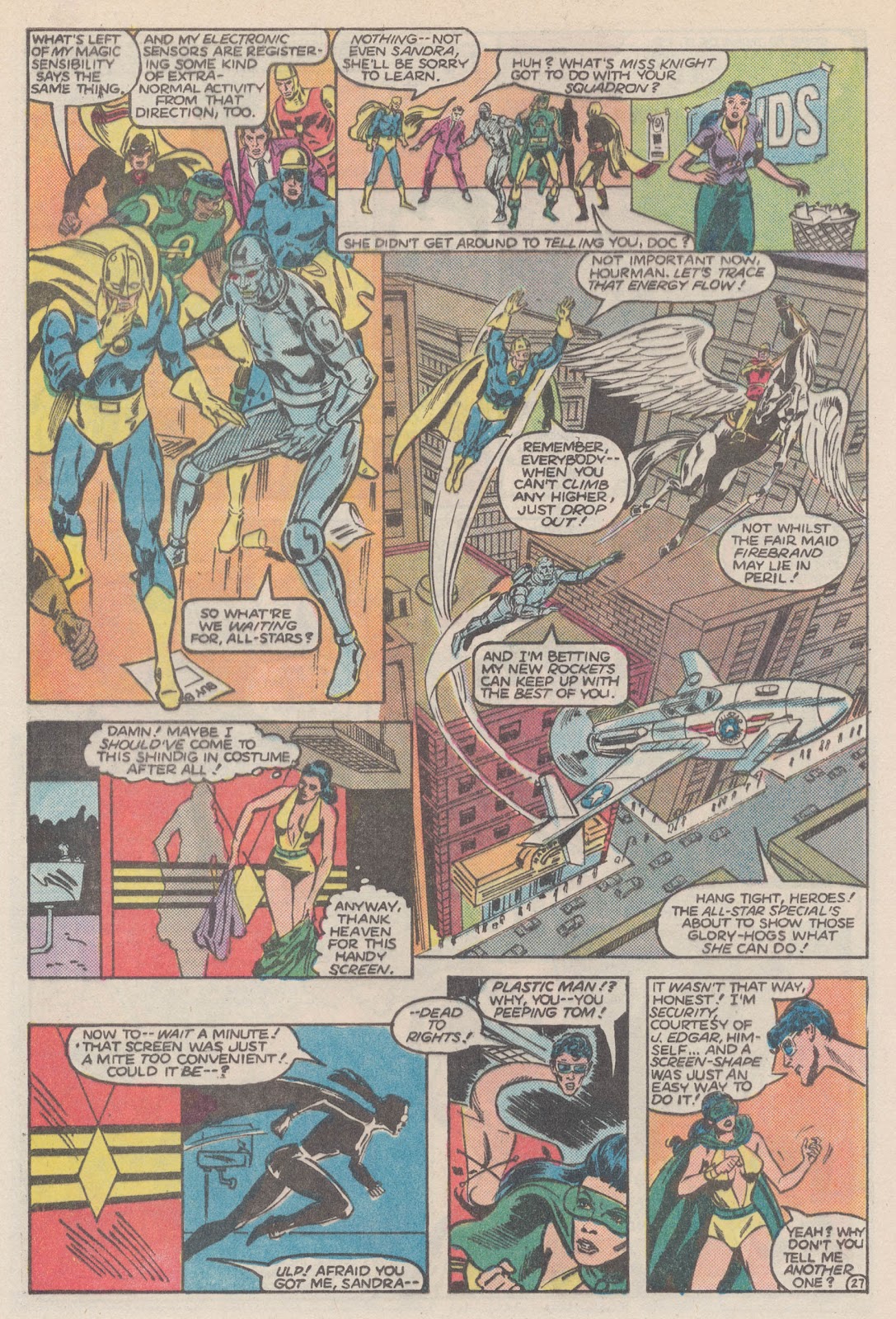 Uncle Sam turns up, with the rest of the Freedom Fighters and recruits Phantom Lady and Plastic Man to accompany them to Earth-X. They agree and soon join the rest of a real Quality group... 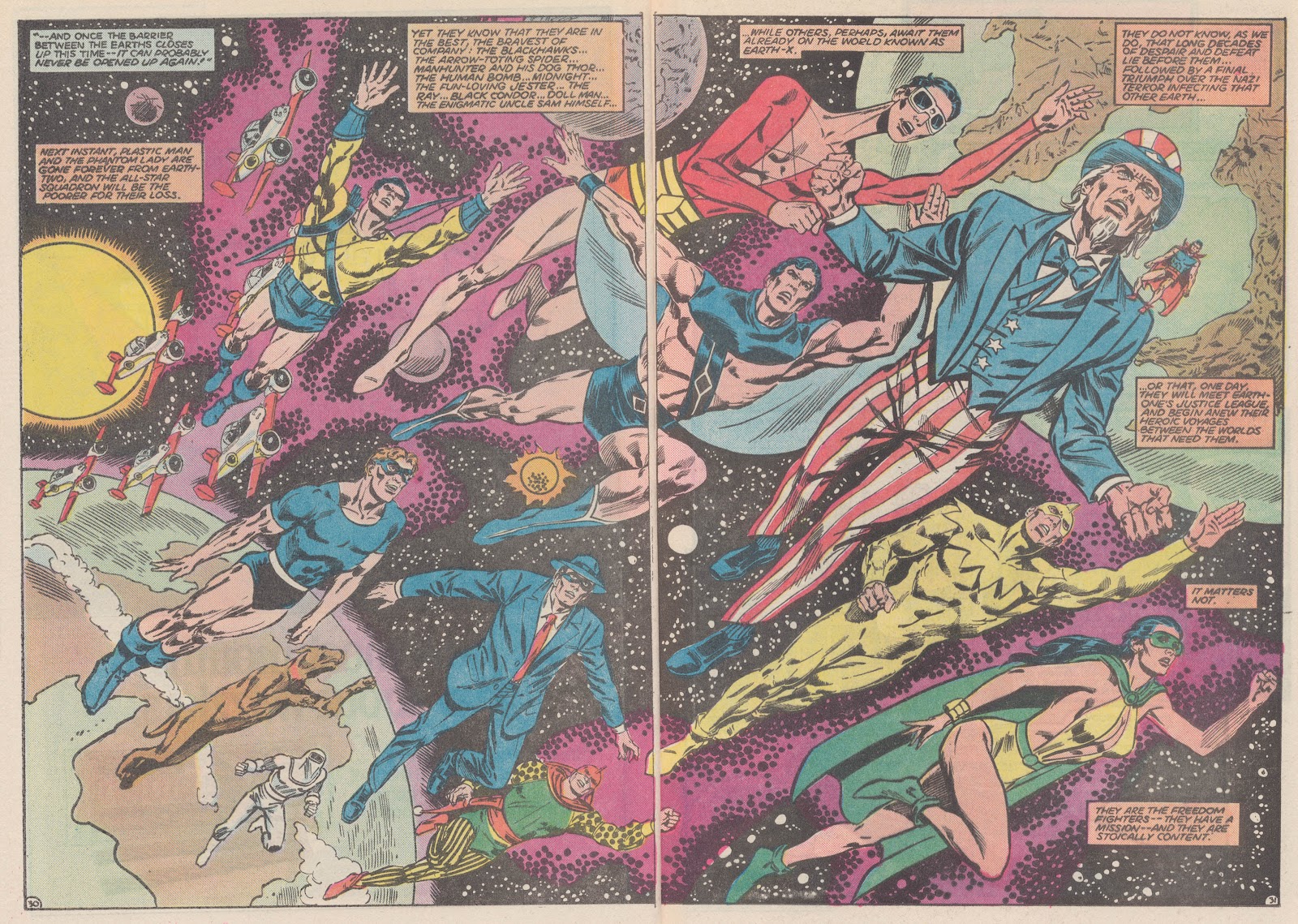 Meanwhile, out of the blue, a marriage occurs... 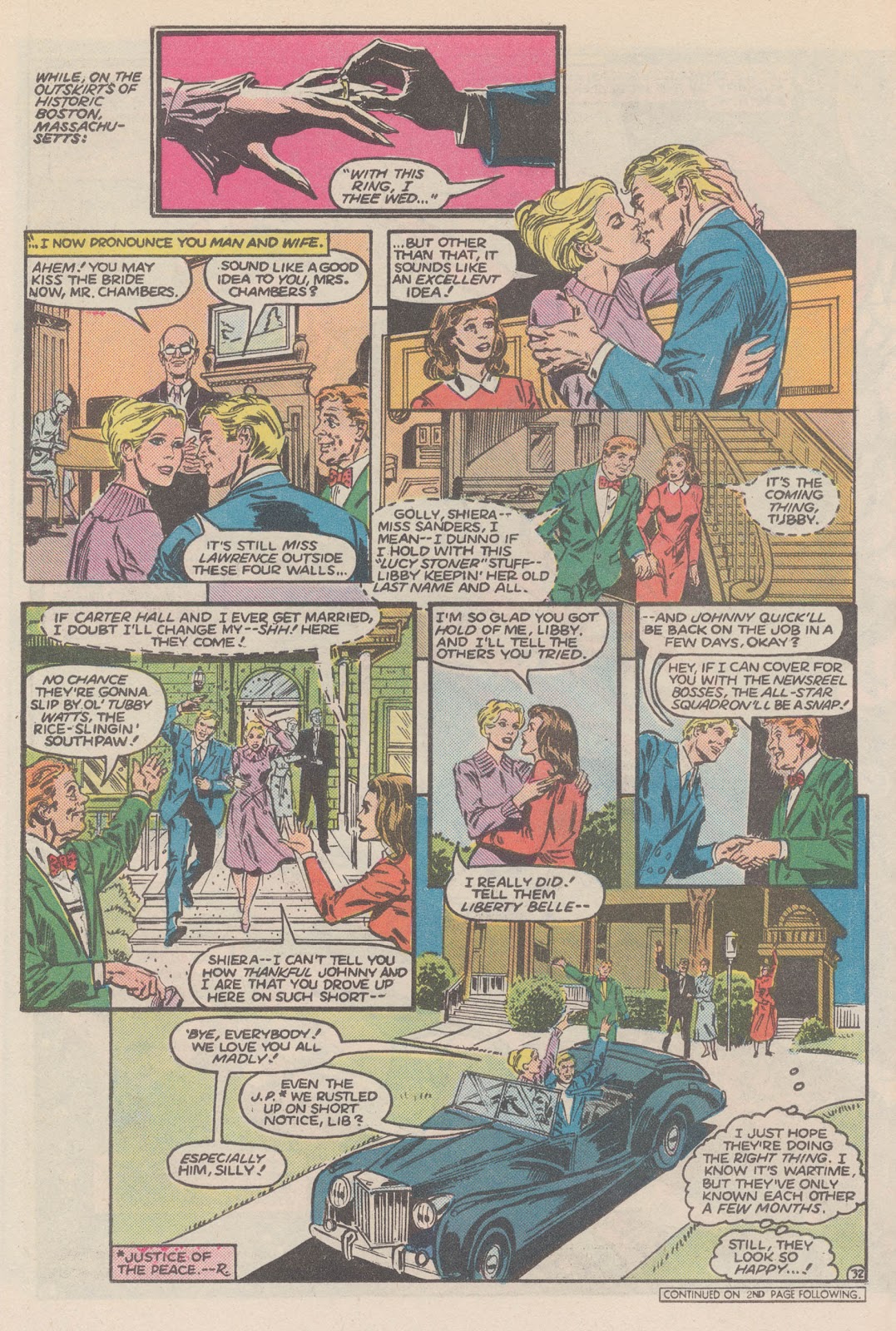 Green Lantern turns up to spoil the honeymoon. Gee, all my aunts did to my sister, on her wedding night, was to short-sheet the bed and hide the towels! They join the others and head for the energy barrier, with some getting through, but Robotman and Dr Fate getting knocked back, to be rescued by Tarantula's web gun. The All-Stars land and they, as well as Steel, in Berlin, figure out something isn't right. Things seem a bit different. They realize they are on another Earth. A small flying device, with a microphone, hovers nearby, spying. 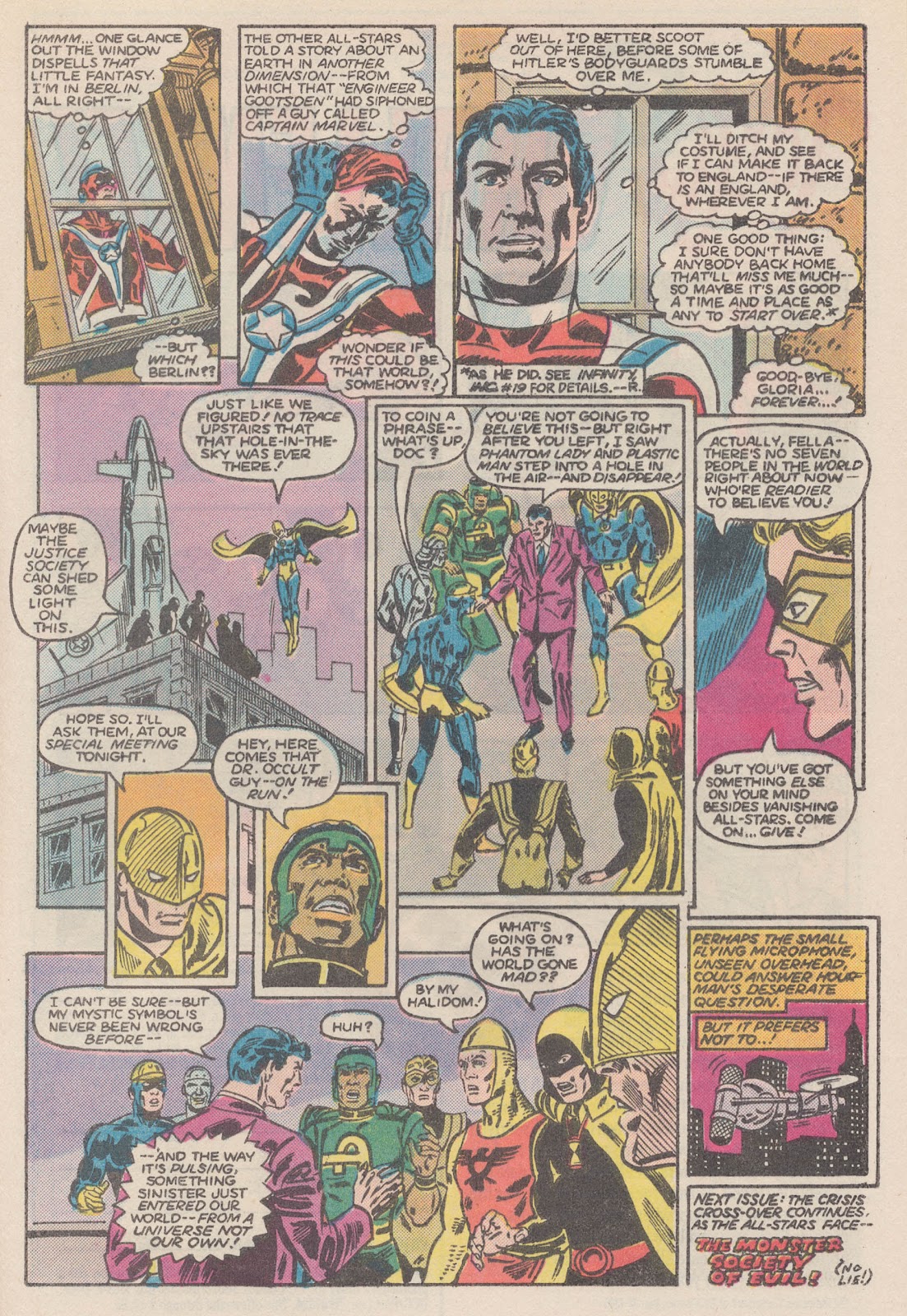 Roy tells us to get ready for the Monster Society of Evil! Does that include Nippo and Mr Banjo? Pinups of Rich bucklers "covers" to the All-Star Squadron Preview (with Starman in place of The Shining Knight) and issue one (minus the picture of Captain triumph). 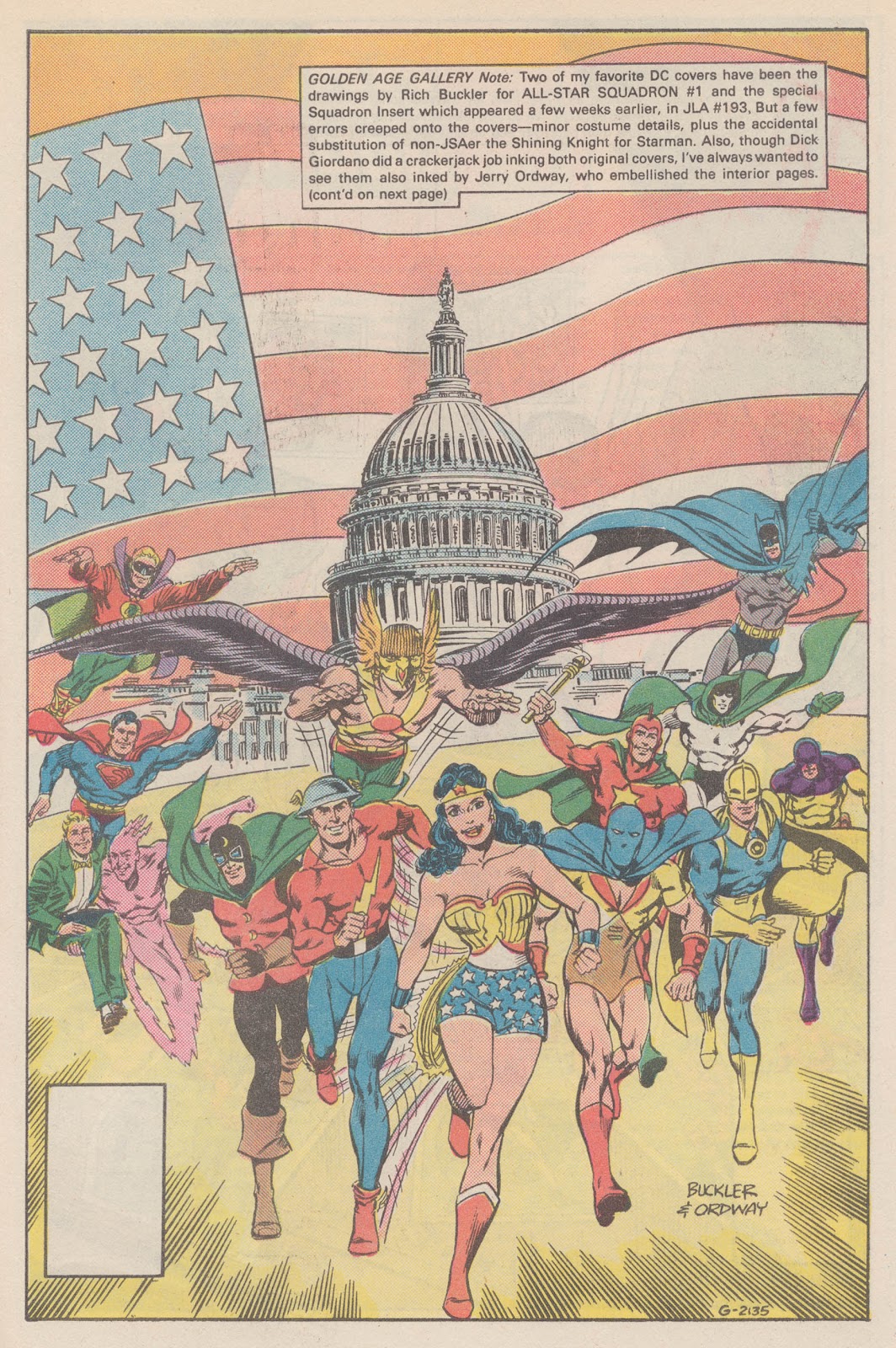 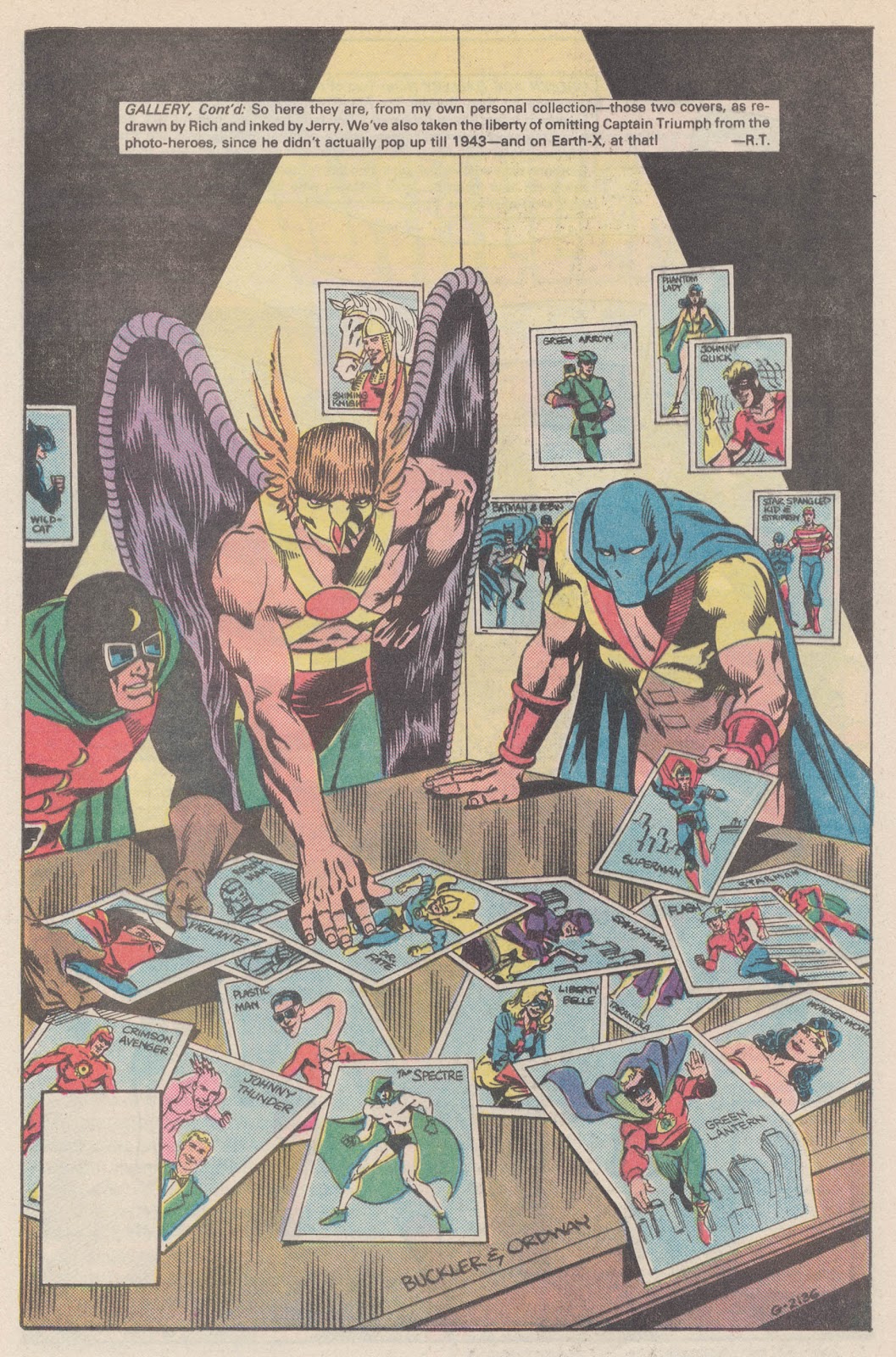 On the letters page, Roy announces that Arvell Jones is stepping down as regular penciler, but will alternate with Mike Clark for the next few issues. The entire year will be taken up by Crisis-related stuff and the 8 JSAers sent into space. Thoughts: Usually, 50th issues are big celebrations, ending storylines or having self contained ones. Unfortunately for Roy, he has to tie into Crisis; but, he is also setting up new phases of action. he does do some celebrating, by gathering all the gang who have appeared (well, in prominent roles, not juts a roll call "aye."). He has to cover a lot of ground, so it feels rather frantic and disjointed. It's not helped by some rather substandard art. This time, I think the inking is to blame, as Arvell has looked much better than this, though Mike Clark is a bit of a rookie. This looks like a Coletta slapped together job and DeZuniga is along for the ride. Lots of things off model, including the Squadron Ascender plane, until the last page. The wedding of Libby Lawrence and Johnny Chambers comes out of nowhere. I get that it is war time and they nearly lost each other; but, this seems rather sudden, even for that. They don't even get a honeymoon, thanks to some Crisis Interruptus! That doesn't bode well for the future (see James Robinson's The Golden Age). Rod Reilly's uniform is just plain wrong; but, I think it is a miscommunication with Carl Gafford. Reilly is wearing a white double-breasted jacket, with shoulder boards and sleeve braiding, white trousers, white cap, white shirt with black tie, collar insignia and black shoes. No such uniform ever existed in the US Navy. The Service Dress Blues have a double breasted jacket, with sleeve braiding; but, no shoulder boards (the rank insignia worn at the shoulder, with a gold star and gold stripes). The trousers are also Navy Blue (black, really). A white cover is worn on the cap, with that uniform. Service Dress Whites, aka "Choker Whites" have white trousers, with a white blouse, which has a high collar that has loops to close it around the throat (hence the "choker" name, as they can feel like you are being choked if they aren't tailored right). Shoulder boards are worn with that uniform, as well as a white cover; but, the shoes are also white (and that uniform is a bugger to keep clean!). There is no combination. I think what was intended was the Serive Dress Khaki, which existed in 1942, but was discontinued when I served (1984-1992, including my midshipman training). That features khaki shirt and pants, black tie, khaki jacket, with shoulder boards, khaki cover and black shoes. Metal collar insignia is worn on the shirt. Also, the jacket has lapels, like the Service Dress Blue jacket; but, it is single-breasted.  Also, there is no sleeve insignia on this uniform (or the Service Dress White; only on the Service Dress Blue jacket). Civilians! The uniform was discontinued in 1975, but reintroduced in 2006, in a test, and authorized for summer and tropical wear in 2008. However, in 2012, it was dropped again because of the cost of re-outfitting every officer in the Navy. We always wanted it, in my day, instead of having to haul out our Dress Blues for more formal things. Those things were rather warm, in Charleston, SC and Choker Whites were kept to things like Change of Command, dances, and other hoity-toity things, where we were playing toy sailor for the public. Khakis were our working uniforms and the Service Dress Khaki was a nice upgrade, for more formal situations. So, of course, they got rid of it. Typical military thinking. Anyway, I think that was what they were going for; but someone didn't get the memo. Otherwise, this would be a decent issue if the art was tighter and had better inking. Man, I wish Ordway was still here! Historical Notes: Mostly just background, as Hawkman namedrops the St Nazaire Raid, where British commandos and naval personnel sailed an old destroyer into St Nazaire and rammed it into the gates of a drydock, with explosive charges set to detonate and destroy the drydock. It looked like a failure, until the time-delay fuses went off a bit later than expected and achieved the mission goal and flipped the bird to the Nazis (and disabled an important drydock which was used to refit German ships). November 1943- US Marines land at Bougainville, as part of Operation cartwheel, the campaign to isolate the Japanese stronghold of Rabaul. Bougainville was targeted as it could provide an airfield for medium range bomber strikes, with fighter escorts, on Rabaul. The marines carried out the initial assault, establishing the beachhead and moved inland. Despite using outdated charts, with minimal updating, the Marines were able to land unmolested, catching the Japanese forces by surprise. Experience from Guadalcanal and New Guinea led to landing transports half full and cargo 1/3 and used 30% of the troops landed for rapid unloading of material. With the Japanese caught unawares, there were no airstrikes on the beaches, facilitating rapid unloading, allowing the Marines to get a large contingent of men and equipment on the beach and move on. Japanese forces were platoon strength and were overwhelmed. The Marines and the Army then moved on to jungle fighting, expanding their perimeter. Seabees were landed and began construction of three airstrips, through December. In January, the encirclement of Rabaul began, with further landings on other islands. The Japanese would launch a counter-attack, in March, which would be fought tooth and nail, to little publicity, before the Allies pushed them back and forced the withdrawal of Japanese troops. The Allies were further reinforced by the 91st Division, the first African-American infantry unit to go into action, in the war. By Novermber, 1944, the operations were turned over to Australian forces, who continued fighting the Japanese in the area until the eventual surrender, in August, 1945. On November 20, the Marines land at Tarawa. Unlike Bougainville and Guadalcanal, the Japanese were expecting the landings and were well entrenched and supplied. The Makin Island Raid, of April, 1942, convinced the Japanese of the strategic importance of the Gilbert Islands and they reinforced their positions there, with engineers builing concrete pillboxes and firing pits, with excellent fields of fire on the beaches. the island was a long, thin triangle, only about 2 miles long and the Japanese installed 14 coastal guns, which could fire upon ships attempting to land troops. The US fleet was the largest assembled, so far, in the Pacific, with 17 carriers (including escort carriers and light carriers), 12 battleships, 8 heavy cruisers, 4 light cruisers, 66 destroyers and 36 transports. 35,000 troops, from the 2nd Marine Division and the Army 27th Division were landed. The Japanese opened fire with 4 of the coastal guns and received counter battery fire from the USS Colorado and USS Maryland, which proved very accurate. One 16 inch shell hit an ammo supply and caused an immense explosion, knocking out 3 of the 4 guns, with the remainder providing inaccurate fire. The landings commenced after. Neap tides prevented the necessary depth to get the Higgins boats across the surrounding reef, as planned, and only amtracks were able to cross, allowing the defenders time to man their firing pits. It took until noon to establish a significant beachhead. Fighting would be fierce and continue through November 23, with mopping up operations continuing through the 28th. By the end, of the 3,600 Japanese defending, only one officer and 16 soldiers survived. Of the 1200 Korean laborers brought to construct defenses, only 120 survived. The marines lost 894, with an additional 84 dying later, of wounds; plus, nearly 2200 wounded. News reports of the high casualties sparked outrage in newspapers and from families, as the public had trouble understanding the Japanese will to fight and die, the extent of their defenses, and the problems of navigation and intel in the island chains,. The Marines were critical of navy planning, which they felt led to the high casualty rate, with most occurring during the 76 hour period between landing and securing the island of Betio, the initial assault location. Tarawa was a major learning field for the Marines and led to the formation of the Navy's Underwater Demolition Teams, to help clear beach obstacles and conduct reconnaissance on landing sites, in advance of an amphibious landing. It revealed the ineffectiveness of naval gunfire on well entrenched troops, as the explosive shells failed to penetrate bunkers. Communication issues had to be addressed. these lessons would inform later landings, at Saipan, Iwo Jima and Okinawa. Allied bombing campaigns over Germany and Italy continued, without major interruptions in German industry. An RAF raid on berlin, on November 18, resulted in the loss of 9 aircraft and limited damage to the city. On November 5, Allied bombs fell on neutral Vatican City, by accident, though blame for the error was never assigned to a specific aircraft. On a slightly more successful note, bombing raids on hydro-electric plants providing power and heavy water production, in Norway, resulted in extensive damage and forced the Germans to move their entire supply of heavy water to Germany, which led to it being lost when the resistance was able to plant a bomb on the SF Hydro, a ferry carrying rail cars of heavy water, sinking it and the materials. The loss effectively ended the German program, as the setback prevented further development of nuclear research. On November 3-4, 43,000 Jews were massacred by Germans and Ukrainian collaborators, at Majdanek, Trawniki and Poniatowa concentration camps, in Poland. It was the largest single-day massacre of the war. Gypsies were added to the list of those to be treated like the Jews and be shipped off to the camps, by order of Heinrich Himmler, on November 15. On November 19, prisoners at Janowska concentration camp, near Lwow, Poland, rose up against their guards, but the rebellion failed and all were killed in the aftermath, with 6,000 dead. The Allies meet at the Cairo and Tehran Conferences to discuss strategy. The Cairo Conference focused on the Pacific and was attended by FDR, Churchill and (EDIT) Chiang Kai-shek. Stalin did not attend, as the soviet Union was still officially neutral in relation to Japan. The US and Great Britain wanted to keep the French from reoccupying Indochina and offered the territory to Kai-shek, who publicly declined. The Allies agreed to continue fighting until the unconditional surrender of Japan and the return of all captured territory, dating back to 1914. Stalin did attend the Tehran Conference, where it was planned to open the Second Front with Operation Overlord, the invasion of France, by the US and Great Britain, while the Red Army would launch a simultaneous offensive in the East. The US, Great Britain and Commonwealth forces would continue to push up Italy, though the higher priority given to Overlord meant they would have to make do with less men and material, continuing the slow progress in the Italian Theater. On the political side, the Partisans were given full rcognition and support from the Allies, in Yugoslavia. Post-War occupation of Germany was discussed and conversations were held which formed the initial basis for the future United Nations. The Soviets agreed to basing 1,000 bombers at Vladivostok, after the Soviet Union declared war on Japan; but, only after the defeat of Germany. An alleged German assassination plot led Roosevelt to quarter inside the Soviet embassy, which had the end result of building trust between him and Stalin, which aided in the negotiations. However, there is conjecture as to whether the plot was real or fabricated by the NKVD (Russian intelligence). Otto Skorzeny, the SS officer who led the rescue mission that freed Mussolini, was said to head up the operation, which he denied in post-war memoirs. The American delegation was skeptical of the alleged plot, which later inspired Jack Higgins' The Eagle Has Landed, where German fallschirmjagger are sent, disguised as Poles, to capture or assassinate Churchill (the Gran Sasso Raid was also an inspiration, and discussed as Hitler's inspiration for the idea, within the novel). The Nazis executed the Lubeck martyrs, on November 10. these were three priests (Johannes Prassek, Eduard Muller, and Hermann Lange) and a Lutheran minister (Karl Friedrich Stellbrink) after delivering sermons which suggested that the British air raids on the city were God's judgement on the Nazis. The three Catholic priests were beatified in 2011. It took until 1993 for German courts to overturn Stellbrick's conviction and clear his name. (Edited due to confusion over which way an Asian name was being presented in history books, as it often isn't consistent. See below)
|
|
|
|
Post by EdoBosnar on Nov 14, 2020 16:45:41 GMT -5
Erm, Kai-shek? His surname was Chiang (also occasionally rendered in English as Jiang).
|
|
|
|
Post by codystarbuck on Nov 14, 2020 18:41:44 GMT -5
Erm, Kai-shek? His surname was Chiang (also occasionally rendered in English as Jiang). Okay, how about Frankie, Winnie and Kai-shek met in Cairo? No? How about Chiang Kai-shek was there to agree to whatever Churchill and FDR wanted, since they were propping him up, as Mao was winning the hearts and minds of the countryside and was better at fighting the Japanese? No? Chiang it is! |
|
|
|
Post by codystarbuck on Nov 14, 2020 18:45:37 GMT -5
ps The cat was supposed to catch that. He's my editor. He was busy trying to perch on my shoulder.
|
|


